Resume Templates
Resume samples

Create and edit your resume online
Generate compelling resumes with our AI resume builder and secure employment quickly.
Write a cover letter

Cover Letter Examples
Cover Letter Samples

Create and edit your cover letter
Use our user-friendly tool to create the perfect cover letter.
Featured articles
- How to Write a Motivation Letter With Examples
- How to Write a Resume in 2024 That Gets Results
- Teamwork Skills on Your Resume: List and Examples
- What Are the Best Colors for Your Resume?
Latests articles
- Top 5 Tricks to Transform Your LinkedIn Profile With ChatGPT
- Using ChatGPT to Prepare for Interviews: Top Tips and Steps
- How to Create an Effective Cover Letter with ChatGPT
- 10 Jobs in High Demand in 2024: Salaries and Expected Growth

Dive Into Expert Guides to Enhance your Resume

The Spanish Resume
Create a resume for a Spanish-speaking job

Certified Professional Resume Writer
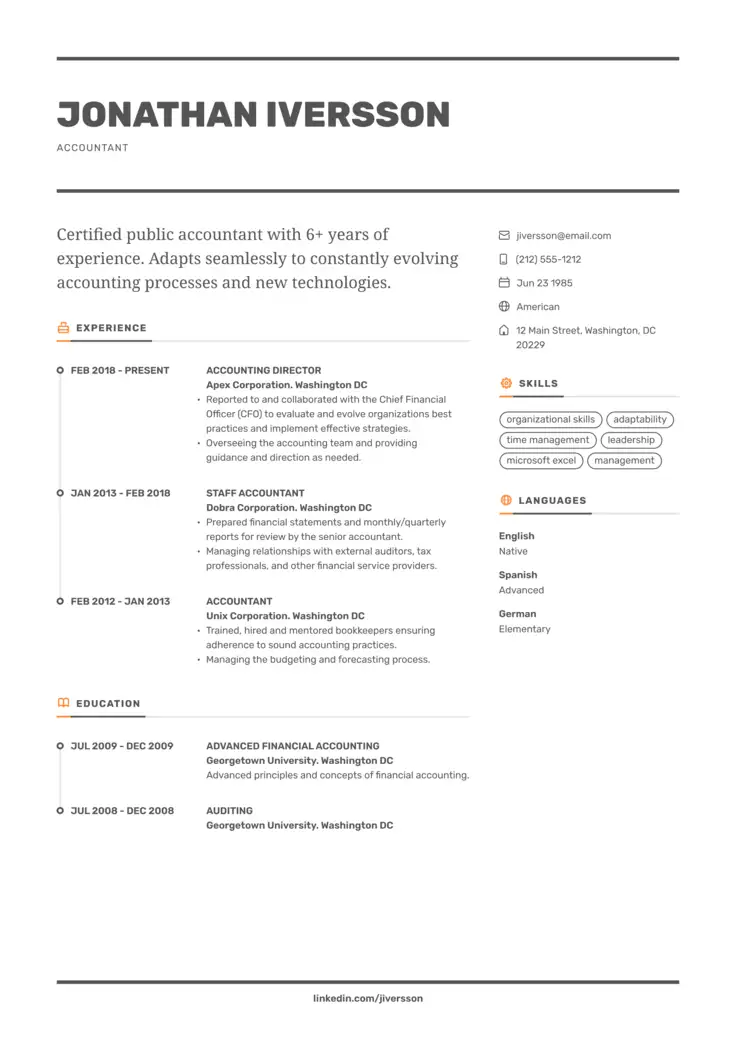
There are approximately 500 million native Spanish speakers in the world and in the US alone, 13% of the total population speak Spanish as their mother tongue. This makes it a very powerful language in terms of business worldwide. Whether you are interested in working within the US with a Spanish-speaking company or you’re looking to go abroad for work, knowing how to write a Spanish resume will be vitally important.
Depending on where you would like to look for work you will need to adapt your Spanish resume , or as it is more commonly known in Europe, your Spanish CV , to the specific regulations of that country. If you are searching for a job in a Latin American country , you should research the recruitment processes and etiquette for resume writing in that specific country before sending your application to ensure you don’t leave anything out that could be crucial for your candidacy.
Other names used to describe the Spanish resume include ‘ curriculum ’ – more popular in Spain – and ‘hoja de vida’ – used in some Latin American countries.
This guide to Spanish resume writing will give you a better idea of how to tackle this challenge as well as a few expert pointers to consider to create an outstanding Spanish resume for your job application.
Writing a Resume in Spanish
If you need to write a resume in Spanish for a job application, it is advisable to go beyond simply translating the information and instead, you should try to write the Spanish CV from scratch taking into consideration the differences in layout and relevant details.
The principal elements that need to be taken into account are:
- Information to include
- Order and importance of sections
- Cultural terms
- Equivalents for grades, courses, etc.
Below you will find more information on these factors to help you structure and complete your resume in Spanish . Firstly, however, are a few general tips regarding creating a resume in Spanish:
- Sometimes, in resumes for the US or other countries, it is common practice to develop work experience descriptions or other sections in paragraph format. In a Spanish curriculum this is not the case and in any areas where you include more information than just basic details of dates and names, you should aim to use bullet points to list the corresponding description.
- Throughout a Spanish resume , candidates should make their achievements and key skills clear by using different action verbs . Examples of good Spanish resume vocabulary to use include: prepare – preparar, achieve – lograr, obtain – conseguir, promote – fomentar, etc. Take a look at Spanish resume examples for more ideas.
- The use of the Spanish equivalent of the first person singular ‘I’ – ‘Yo’ should be limited. Instead use simply the past or infinitive form of the verb to explain accomplishments or responsibilities from previous experiences.
- Once you’ve finished your Spanish resume and you’ve included all the relevant information without overloading it, it is highly recommended that you should ask a native speaker to proofread the finished product because it may be a foreign language to you but the hiring manager will spot mistakes in an instant and any spelling or grammar mistakes could potentially ruin your chances of making it to the interview stage.
A resume in Spanish example will help candidates understand what is important to include and what is not for their job application in Spain or to another Spanish-speaking country.
Spanish Resume: Layout and Sections
When it comes down to structuring a Spanish resume , it is essential for applicants to take a look at the Spanish resume format to understand how a resume in Spanish should be laid out, what information should be included and what should be excluded. One way to do this is to employ Spanish resume templates that are pre-structured in a format that Spanish-speaking recruiters know well, in order to offer them the information in an easily recognizable order.
- The general rule for the length of a Spanish resume is to maintain all the information within 2x A4 size pages maximum. This is already more than necessary because recruiters do not have much time to spend reviewing the many resumes they receive which means it is essentially better to aim for just one page, however, 2 pages are acceptable for candidates with a long, relevant work history.
- The margins and white space on a Spanish curriculum should also be considered because the technical resume formatting for different language resumes can vary. In standard Spanish CVs, margins should measure 3 cm (just over 1 inch) from the top of the page and 2.5cm (1 inch) from each side.
- Another rule to take into account to create a correct Spanish resume format is the heading or title you put at the beginning of the page. It is important that this area is not given the title ‘Spanish resume’ or simply ‘Resume’, ‘CV’ or ‘Curriculum’. The header should include the applicant’s full name and the relevant personal details.
Once you understand the format that is necessary for a Spanish resume to fit the criteria of Spanish employers, you can use a resume in Spanish example to see how you can adapt your resume to their requirements.
What to include in a Spanish resume?
Other than the language, there are additional factors that must be considered when writing a resume in Spanish . These elements encompass what sections should appear on a Spanish CV in order to catch the hiring manager’s attention.
If the curriculum is not well-formatted and laid out in the corresponding order, you could easily find your Spanish resume being rejected from the very beginning. To ensure this doesn’t happen, follow these guidelines of what to write in your resume in Spanish :
Unlike the 88% of US recruiters who reject resumes with photos, recruiters in other countries expect a Spanish curriculum to include a professional profile picture . This passport-sized photo is included on the front page of the resume. It should show only the head and shoulders and should not be taken from another photo but be professionally shot for this purpose.
If you are uncomfortable including a photo on your Spanish resume , it is not compulsory and the ‘anonymous CV’ is becoming more and more accepted in Spanish companies so it should not cause a problem. However, candidates should be aware that traditionally Spanish-speaking recruiters are accustomed to seeing this photo as part of the professional profile of an applicant.
Personal Information
Datos personales
Either with the photo or in a header for your resume, you should include a section dedicated to contact and personal information for the hiring manager to be able to identify you and have your contact details to hand if they are interested in discussing further your application.
This area should include the candidate’s details as follows:
- Full name – Nombre completo (First and Last name = Nombre and Apellido).
- Age or date of birth – Edad or fecha de nacimiento.
- Full address or alternatively a general location such as the region or city where you’re
- looking to work – Dirección or Ubicación (Estado, Zona, Región, Ciudad).
- Email address – Correo electrónico.
- Phone number – Número de teléfono.
- Nationality – Nacionalidad.
Also, if applicable the candidate’s ID number that proves their right to work in the country to which they’re applying. In Spain this is called a NIE – numero de identidad extranjero – giving the bearer permission to be contracted and pay into the tax and social security system. Check the name and nature of this document if you’re applying to work in a different Spanish-speaking country.
Additionally here you can add information regarding your availability of timetable and your driving licence type or other major certificates you may hold that could be beneficial to your job application.
Education/Training
Formación Académica Often found in second place on a Spanish resume , especially for entry-level or student resume candidates, is the education or training section, dedicated to demonstrating the candidate’s qualifications and certificates.
The information that should be included in this section includes the following:
- Name and type of qualification (where possible offer the Spanish equivalent).
- Corresponding start and finish dates (If the course is still undergoing, use the term ‘en curso’ to explain that the certificate has not yet been awarded).
- Location and/or academy name.
- Grade – if relevant (It is not necessary to include your GPA but if you wish to add a grade to demonstrate high academic achievement, work out the equivalent for the country you’re applying to so the hiring manager has a frame of reference to better understand the accomplishment).
If you have various diplomas, it is only necessary to include the most relevant and recent certifications to demonstrate to the prospective employer your training in the specific area you want to work in.
In a Spanish CV, if you have undertaken professional courses or training programs , these will usually be included in this section. It does not only refer to academic degrees. If, like many jobseekers these days, you have both professional and academic certificates, combine the most pertinent information regarding the different courses in this same section to provide a well-rounded image of your professional expertise to the hiring manager.
Professional Experience
Experiencia profesional Usually in third position on a Spanish resume , the work experience section should give a list of the most recent and important positions you have held. In order to structure the job history section correctly, you can see how Spanish resume examples demonstrate the previous posts in reverse chronological order and every candidate should do the same so that potential employers get a good idea of the career progression.
Each entry in the work experience section should follow the same format:
- Name of position/Job title
- Company name or sector (If the company is unlikely to be known or understood, explain briefly the industry it is dedicated to.)
- Dates of employment
- Description of tasks and responsibilities
In addition to all paid professional experience, candidates should include internships and significant volunteer experience in this category because in a Spanish resume, it is common practice to combine these various experiences as opposed to separate them into different areas.
Bear in mind that if you use the full date in your Spanish resume at any point and are applying for work with a European company, you should adjust the date to the DD/MM/YYYY format.
Remember only to include the most relevant job history that relates directly to the company, industry or position you’re applying to.
Competencias/Aptitudes A section dedicated to hard and soft skills is not traditionally found on a Spanish resume, however, it is becoming increasingly common and it could give you the upper hand in the job application process if you directly demonstrate to the hiring manager that you possess certain abilities that other candidates do not claim to have.
The most essential skills that you should mention in this section are those that establish you as the ideal applicant for the position in question. The best way to know what these skills are is by researching well the vacancy on offer and using the job description as a guide to find the key skills required.
Some of the most crucial skills to highlight on a Spanish resume include linguistic abilities and IT skills. If you are particularly gifted in one of these two areas, you can create a separate section that deals with just these capabilities.
Idiomas If you choose to add your linguistic abilities to a specially dedicated languages section or include them within your general skills section, you should remember to list not only the language you master but also the level to which you are able to use it in a professional capacity.
For a resume for Spain , candidates are recommended to list their linguistic abilities according to the Common European Framework of Reference (CEFR) for languages, which rates the level of fluency between a scale of A1 (most basic knowledge) to C2 (native fluency).
If you have completed any universally recognized exams , such as a DELE (Diploma de Español como Lengua Extranjera = Diploma of Spanish as a Foreign Language), these should be included in this section. This will allow the hiring manager to gain a better understanding of your level.
You can also use a more global scale if you are applying to work in a Spanish company in the US or elsewhere. The following are some general terms to describe linguistic abilities:
- Beginner – Inicial/Principiante
- Elementary – Básico
- Intermediate – Intermedio
- Advanced – Avanzado
- Bilingual – Bilingüe
- Mother tongue – Lengua materna
Competencias de informática Candidates should determine the types of IT programs or languages they can use to demonstrate to the hiring manager their capabilities in this area.
For example, it is more common to see Microsoft Office included in Spanish resumes than American ones; it is referred to as Ofimática. For other programs, it is important for candidates to use the technical names and if necessary add an explanation as to the main function so the hiring manager can understand the suitability of this skill as part of the job application.
If it is not relevant to the position you are applying for, it is not necessary to include a section dedicated to your IT skills unless it offers something to your application that competing candidates might not have which could be useful to the vacancy or company.
Aficiones Only around 30% of Spanish recruiters favor a section on interests and hobbies, but it is still sometimes sensible to include one. This segment can give a potential employer a better, more well-rounded idea of the applicant . Sometimes, it can even be the turning point, if the candidate adapts their resume well to the vacancy or specific company culture, encompassing shared values into the free-time activities mentioned here.
Do not add this section if you feel it does not fit well with the type of position you are seeking or the specific business you’re applying to. The idea is not to waste a hiring manager’s time but to engage them with relevant information by supplying a well-structured and informative Spanish resume.
Using a Spanish resume builder will give you the best Spanish CV templates with professional examples to understand how to optimize your job application in Spanish. ResumeCoach gives jobseekers the ability to make their resume in various languages through the multi-lingual online resume builder application so you can get a jumpstart on your Spanish resume with expert tips.
Spanish Resume Example
One guaranteed method to create a Spanish resume that will catch the eye of the hiring manager is to employ a Spanish resume example to guide you with tips and sample texts to use in the various sections.
An example of a resume in Spanish can help candidates choose what sections will be useful for their customized job application and show them how to format a resume that will stand out from the competition. Example Spanish curriculums will be complete with typical Spanish resume terms and phrases that are common to Spanish speaking recruiters.
In addition to resume examples in Spanish and using a Spanish resume template , candidates are also advised to review cover letters in Spanish which are better known as cartas de presentación. To complete a job application for a vacancy in Spain, Mexico or another Spanish speaking nation or company, it will be necessary to present both the Spanish curriculum and the cover letter.
Difference between American and Spanish Resumes
There are always similarities and differences to be considered when you need to create a resume to apply for a job in a different country or simply using a different language. Moving from one language to another implies much more than simple translation of words, and applicants should take care to respect cultural differences that may apply when job searching in different countries.
Although both the Spanish and American resumes are generally short and do not exceed 2 A4 pages as a standard rule, it could be construed that the Spanish resume has overall less detail. This is because it is only now becoming more common to include a list of the achievements or responsibilities held in previous positions. Therefore many older Spanish-speaking jobseekers will not complete their professional experience section to such a degree as the current generation.
Additionally, it is also only recently becoming more popular to include a skills section which displays the different hard and soft abilities of the applicant. Thus, frequently Spanish resumes will be seen with much less detail than American resumes.
Resume in Spanish for Mexico
To write a resume in Spanish for a job application in Mexico , there are several aspects that candidates should consider before handing over a traditional Spanish resume.
Firstly, again a resume in Spanish cannot simply be a translated version of your normal resume because it may not tick the boxes of what is required by a Mexican employer .
Generally in Mexico, the resume is also known as a CV or currículum , and does not differ majorly from the resume for Spain or hoja de vida that we have described previously.
In Mexico, education is one of the most valued sections and should be included with more detail than the typical American resume, listing college activities, honors and awards , etc.
In addition to the aforementioned sections, the Mexican resume includes a part that is dedicated to updates – Actualizaciones. This means instead of adding new courses, professional training sessions or diplomas to the education section, any of these that have given you new expertise would be listed here under this heading.
If you’re applying for a job in Mexico or another Spanish-speaking country, you can use an online resume builder to create your resume in Spanish in no time with no fuss.

Struggling with Resume Writing?
Ease the process with our templates
How to Build a Resume in Spanish + Sample CV

What’s inside…
Table of contents, important notes, showcase your passions outside of work, define a goal or write a personal summary, spanish resume vocabulary to know, professional resume in spanish: example, bonus: where should i send my spanish resume, structure of a spanish resume.
A work resume in Spanish isn’t entirely different from an American resume. Of course, there are a couple of unique Spanish CV format characteristics (we’ll get into that later), but you’ll probably find the overall structure somewhat familiar.
First off, similarly to American practices, try to keep your resume to one page. Divide the page into the following sections:
- Datos personales, generales o de contacto (Personal information and contact) ➡️ this should include all the relevant personal information, including your full name and contact information (professional email, phone number, any applicable websites or social media pages, your home address, etc.). One difference from the American formula is that you might also include your date of birth in this section.
- Objetivo, resumen o perfil (Objective/Summary) ➡️ one or two sentences about your application.
- Experiencia laboral (Work experience) ➡️ your past work experience, including dates of employment, company name, and job title. You can also briefly outline your responsibilities.
- Formación académica/Estudios/Formación (Education/Training) ➡️ list your degree(s), certificate(s), and the institutions you’ve attended.
- Idiomas (Languages) ➡️ the languages you speak, including your level. You can use the CEFR (European reference scale) to define your level (A1, A2, B1, B2…) or give a general description: beginner , intermediate , advanced , bilingual , etc.
- Informática (Technology) ➡️ if applicable to the position, include your relevant software and technology skills and your level.
- Actividades extracurriculares (Extracurricular activities) ➡️ this is a list of your activities outside of work: hobbies, volunteering, sports, etc.
- Información adicional (Additional) ➡️ you can add a “bonus” section with any additional information that you think is relevant to the position. For example, you could include any time you’ve spent abroad studying Spanish or other languages.
- Referencias (References) ➡️ these are people (former colleagues, clients, supervisors, etc.) who can speak to the quality of your work.
🎓 💼 Which should you highlight on a job application in Spanish – education or work experience?
It all depends upon your situation. Like in the U.S., if you’ve just graduated and don’t have much professional experience yet, you should put your education at the forefront, including your subject matter studied.
If your professional experience is closely related to the job you’re applying for, focus on that. If you’ve only had one job, but it’s a direct match to the one you want, then by all means make that clear on your resume.
📸 Photo or no photo?
It’s up to you. In the U.S., we’re not used to the practice of including a photo on our resumes, but it isn’t uncommon in much of Europe and South America. It’s certainly not a requirement, but if you do opt to include a photo, make sure it’s professionally taken, well-centered, and a good-quality image. And don’t forget to smile and look confident!
What’s Unique About a Spanish Resume?
As we’ve said above, there are lots of similarities between resumes in the U.S. and Spain. But they’re not identical – here are a few more differences to anticipate.
Generally, recruiters in Spain place a high value on “extra-professional” activities and experiences (volunteering, sports, hobbies, etc.), as well as all of the more personal factors that may be relevant to your application for a position. They’ll want to get a picture of who you are as a person , and an idea of the personality traits you would contribute to their team.
Even if it’s not required, it might be a good idea to include an “ objetivo ” in your resume. This provides more detail about your personal goals, your motivation for applying, or a brief summary of your personal profile . It should be an eye-catching hook no longer than two lines , and it should of course be tailored to the position you’re applying for.
Start improving your Spanish today
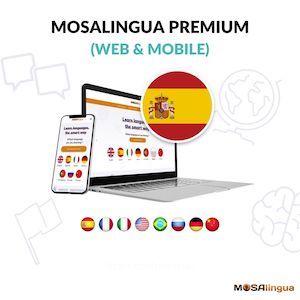
Good news: we can help! More good news: you can get started for free! With your free trial , you can test drive the most effective method for learning Spanish for the next 15 days !
Vocabulary flashcards, videos with subtitles, audiobooks, articles adapted to your level – with MosaLingua Premium (Web & Mobile) , you’ll have access to all this and more. Get started right now. It’s free—and risk-free—to try!
Try MosaLingua Premium today
Maybe the most important question… How do you say “resume” in Spanish?
Currículum or CV español.
In some parts of Latin America, you’ll hear the term hoja de vida.
Other important vocab:
- cover letter = carta de presentación
- professional experience = experiencia laboral
- internship = prácticas
- relevant skills = habilidades relevantes para el puesto
- professional achievements = logros más relevantes
Terms related to academics ( formación académica )
- diploma = certificado de estudios
- high school diploma = bachillerato
- technical certificate (roughly equivalent to an associate’s degree) = técnico superior, grado superior
- bachelor’s degree = grado universitario
- master’s degree = máster
- doctorate (PhD) = doctorado
- high school = secundaria
- preparatory classes = clases preparatorias
If you’re not sure where to start, here’s a sample resume to help you get a feel for the Spanish CV format.
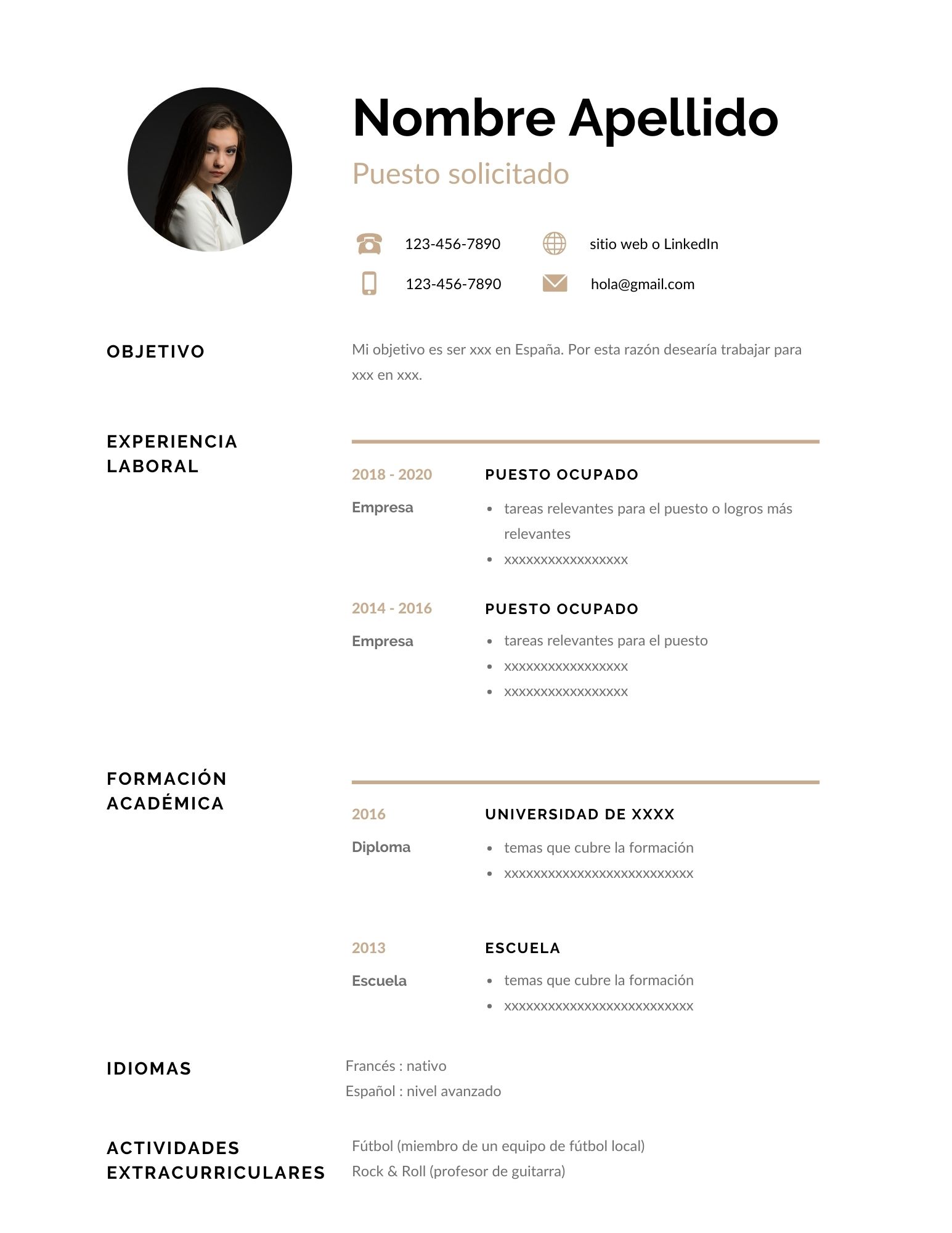
Finally, don’t forget that the person looking at your resume is probably going to be looking at dozens of others, as well. Try to stand out from the rest by creating something original and personal .
That being said, it’s crucial that your resume be legible and clear. You should definitely type it on a computer, using a neutral font and an easy-to-read size . Organize your resume with some space between each section , and use clear headings .
Don’t hesitate to have a Spanish tutor or conversation partner look at it before you submit it. They can help you catch any grammar, spelling, or vocabulary usage mistakes!
If you’re just beginning your job hunt in Spain, you may want to start with a job search engine. These sites make finding and applying to relevant jobs easy. Don’t forget to upload your shiny new Spanish resume! The main Spanish career sites that natives use to find their next job are:
To go further, have a look at a couple of other articles that might be useful to you:
- Learn more about how MosaLingua’s Business Spanish app can help you
- The Best Online Translators and Online Dictionaries for Language Learners
- The Easiest and Fastest Way to Learn Spanish
Related posts:
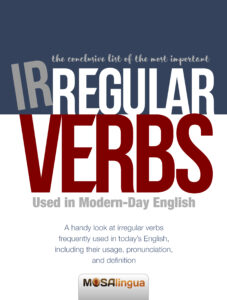
Did you like this article?
Thanks in advance for rating this article, it will encourage the author to write more
One click won't cost you anything, but it would mean a lot to us:
Want to start improving your language skills today.
Mathilde is a French copywriter and content creator. When she is not travelling, Mathilde likes to taste new flavors and cook delicious food. She loves to ride under the sun of California and enjoys her free time in the wild. She speaks: French, English, Spanish, and Portuguese
Natalie is a translator from the United States. She has taught French in the US and English in France, and she always enjoys learning and helping others make connections with languages. She speaks English and French, and is learning Italian.
Building a Resume in Spanish
Applying for a job abroad? Or are you simply interested in joining a Spanish-speaking company in the US? You’ll make an impressive impact if you submit a resume in Spanish. However, it’s not as simple as translating your resume word for word – there are terms and cultural norms to consider that make your resume feel natural. This blog discusses key sections in a Spanish resume, Spanish terminology, and the top tools that can make you stand out from the crowd.
When a resume in Spanish comes in handy
Speaking another language is a great asset and can be useful in landing you a great job. One of the most common is moving abroad – if you’re settling down in Spain or Latin America, showing off your language skills with a Spanish resume is essential.
You’ll need an expert command of the Spanish language to do this successfully. You’re competing with both locals and other expats, so an expertly crafted Spanish resume is crucial.
Even North America relies heavily on Spanish language skills. The United States has the world’s fifth-largest Spanish-speaking population, behind Mexico, Colombia, Argentina, and Spain. (1) The language is most prominent in:
If you’re planning on working for a company in any of these states, you could pass up a great opportunity working for a Spanish-speaking company if you don’t know how to write a work resume in Spanish.
Pay attention to the job ad you’re targeting. If the job description is in Spanish or requires native proficiency, it’s obvious that a Spanish resume will be helpful, but it can be more nuanced than that. If the job post mentions that Spanish language skills are preferred, you can make a great impression by sending in a Spanish resume.
Similarities and differences between Spanish resumes
Just because two companies use the same primary language doesn’t mean you should use an identical resume. If your dream job is in Spain, your resume will be a lot different than if your dream job was in Latin America.
This rule is the same with every language. Let’s use English to put this in perspective. When applying for a job in England, you would want to label your resume as a “CV.” But this term is nearly non-existent in America, so an American hiring manager may not know what it means.
Let’s take a look at the main differences between different Spanish resumes so you can align yours perfectly to your ideal role.
Grammar and vocabulary
Grammar in different Spanish-speaking countries varies considerably.
One example is the use of the first-person pronouns “tú” and “usted.” Many areas of Spain consider “usted” to be rather stuffy and formal, while most of Latin America uses it when addressing anyone outside your inner circle of family and friends.
Another first-person pronoun is “vos,” which is common in North and Latin America but rarely heard in Spain.
It’s also important to note that the word “resume” varies between Spanish-speaking countries. Spain may use the term “CV,” but some parts of Latin America use “hoja de vida,” “currículum,” and “resumen.”
Cultural values
If you want to add extra flair to your Spanish resume, it’s a good idea to match the workplace cultural values of the country.
Latin America and Spain have values in common, such as promoting relationship-building and close friendships, but they also have key differences. For example, Latin America has a greater emphasis on agility, hard work, and collective success, while Spain favors a relaxed approach and respecting leadership.
Key components of a Spanish resume
A Spanish resume isn’t too different from an American one when it comes to structure and formatting . It includes a header with contact details, a resume summary, work experience, and skills, like most resume templates . You can also add optional extra sections, just like in English.
Here are the key sections to include in a Spanish resume:
- Header: “Datos personales” : This section should include your full name, phone number, email address, and location.
- Resume summary: “Perfil” : Two to three sentences about your experience and career goals.
- Work experience: “Experiencia laboral” : A brief summary of your work history, including job title, company name, date of employment, and a few achievements.
- Education: “Estudios” / “Formación” : Provide the degrees you hold and the institutions you earned them at.
- Skills: “Competencias” : List your top skills that are the most relevant to the position.
- Languages: “Idiomas”: This section should contain the languages you speak, using the CEFR scale to show proficiency.
- Additional information: “Información adicional” : Any extra information you think enriches your resume, from volunteer work to internships you’ve had in Spanish-speaking areas.
These are the most common terms to use in a Spanish resume but always research the customs and language of the specific country you’re targeting. You want to ensure that your language is not only understood by the hiring manager but also appeals to their norms.
The above list is the preferred order of sections, just like in English. However, be aware that the sections can shift based on your needs. For example, students and people with little work experience should place education before work experience.
“If you want to add extra flair to your Spanish resume, it’s a good idea to match the workplace cultural values of the country.”
Optimizing your work resume in Spanish
Let’s dig into a few tips specific to Spanish resumes. While they’re similar to English-speaking applications, Spanish resumes have unique qualities. Taking the time to include them makes you more natural among local candidates and makes you stand out among expat candidates.
Here are a few unique features of a work resume in Spanish:
- Including extra details in your header : It’s more common to add nationality and date of birth in your contact details.
- Adding more personal details : Some Spanish-speaking countries, like Spain, prefer a holistic view of a candidate, so it’s a good idea to add extra personal details like your hobbies and interests.
- Providing a photo : A photo in your resume seems odd to many Americans, but it’s common practice in Spain and most of Latin America. Be aware that Mexico is just like America, so exclude the photo when applying to a job in Mexico.
Another top tip we can give to all job seekers is this: if you aren’t sure of your abilities to build a Spanish resume with correct grammar, don’t do it. You can send your resume to a translator to double-check terminology, but it’s best to have complete assurance in your language skills if you’re applying to a role with a Spanish resume.
Research the culture of the company you’re applying to as they can vary greatly. Spanish-speaking American companies may have customs and values that match typical American culture. On the other hand, rural companies in Spain may have old-fashioned customs different from urban Spain.
Additional resources and tools to build a successful resume in Spanish
You have a lot to consider when building a Spanish resume, so it’s best to have a tool to handle the rest for you. Crafting a resume with software like CVwizard’s Resume Builder enables you to focus on cultural details and terminology with formatting and structure taken care of for you.
For insights that are relevant to both English and Spanish resumes, we recommend you take a look through our resume articles . You’ll find a wealth of insights, including how to add your education and contact details, and how to build unique, creative resumes.
Build a Spanish Resume That Impresses Every Employer
Submitting a resume in a different language can be intimidating, but with your skills and our guide, you can craft a Spanish resume that catches the hiring manager’s eye. Just follow our top tips:
- Research the company and its customs
- Use terminology relevant to the country you’re applying in
- Include extra details, such as your photo and date of birth
Now that you know the top tips for building a Spanish resume, take the advice and apply it to your specific industry. Browse our collection of resume examples to learn tips tailored to your specific role.
References:
(1) Statista, August 8, 2023: Countries with the largest number of native Spanish speakers worldwide in 2022
Make an impression with your resume
Create and download a professional resume quickly and easily.

How To List References On Your Resume

Listing Education on Your Resume

Should You Include Nationality on Resumes?
Spain Resume Examples and Writing Tips
Applying for a job in Spain? Learn how to write a job winning Spanish resume with this guide. We have provided 10 Spanish resume examples and templates that you can use to write your own.
What Sections are Important to Include In a Spanish Resume?
Most Spanish resumes are expected to have the following sections in it:
- Work history
- Education section
- Contact information
- Date of birth
It is integral to your Spanish job search that your CV doesn’t stand out for the wrong reasons - it should be eye catching because it is a great CV, not because it is missing key information.
If you are trying to write a Spanish resume and wish to list your Spanish resume sections with a Spanish title, here's how you can do it:
- Encabezado in place of Header
- Objetivo instead of Objective
- Experiencia Laboral instead of Work History
- Habilidades instead of Skills
- Formación Académica instead of Education
Browse our gallery of resume examples here.
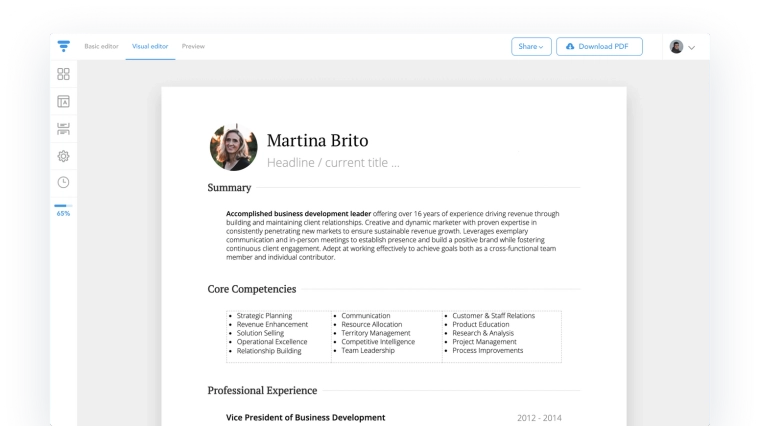
Spanish CV Example
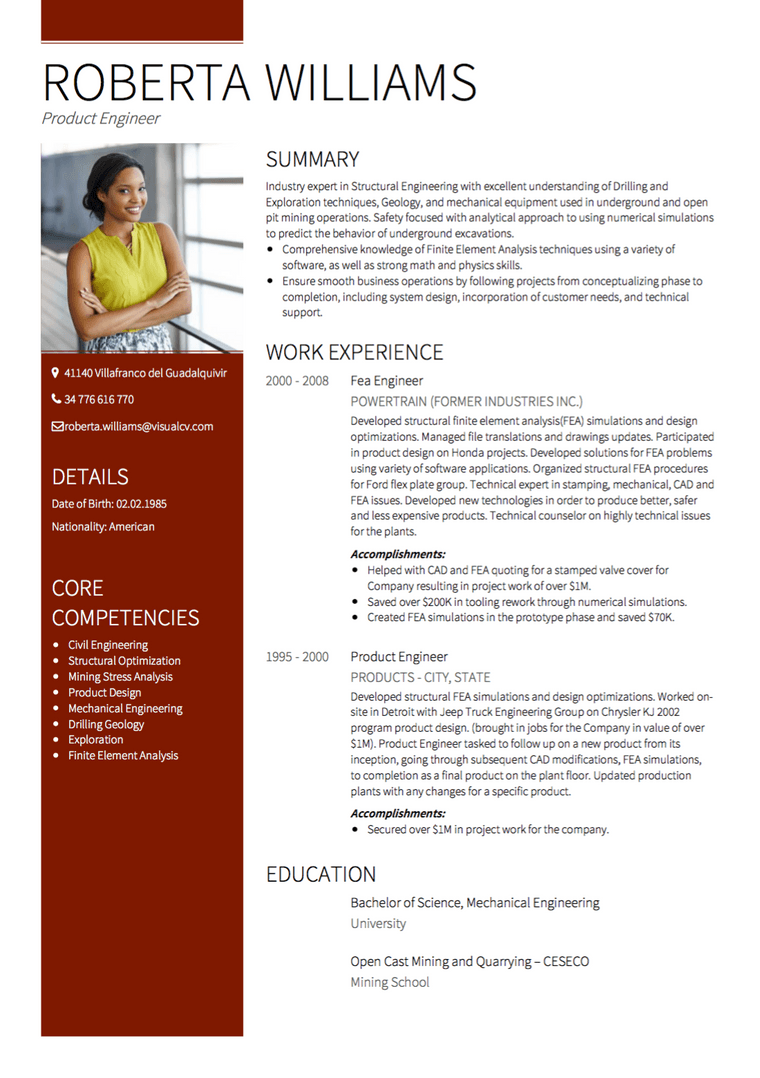
Spanish CV Tips and rules:
Length: No more than two pages are necessary in your CV for Spain.
Layout: Use clear headings and sections - you want employers and recruiters to be able to scan your cv quickly and efficiently.
How to Format a Spanish Resume
To format a Spanish resume:
- Start with a layout for your resume in mind. Your choices are: Reverse chronological, functional or a hybrid resume layout.
- Use a margin of 1 inches on all side to ensure that when anyone holds your resume, it won't hide any content on it.
- Use bullet points instead of a paragraph to describe your work experience.
- Use a maximum of two fonts. If you are using two fonts, use one for heading of each section and the other for descriptions.
- If you are planning to use Spanish words, ensure that you have everything right - including the specific characters and the punctuation.
10 Spanish Resume Examples and Templates
Reverse chronological spanish resume example.
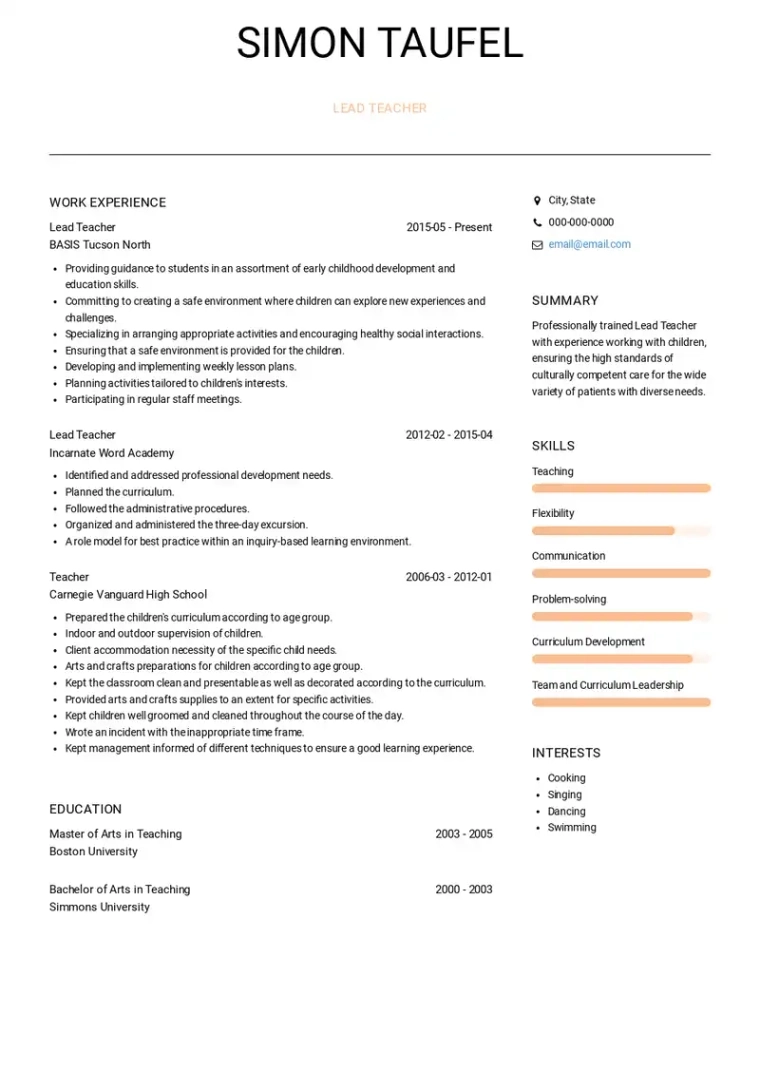
Functional Spanish Resume Example
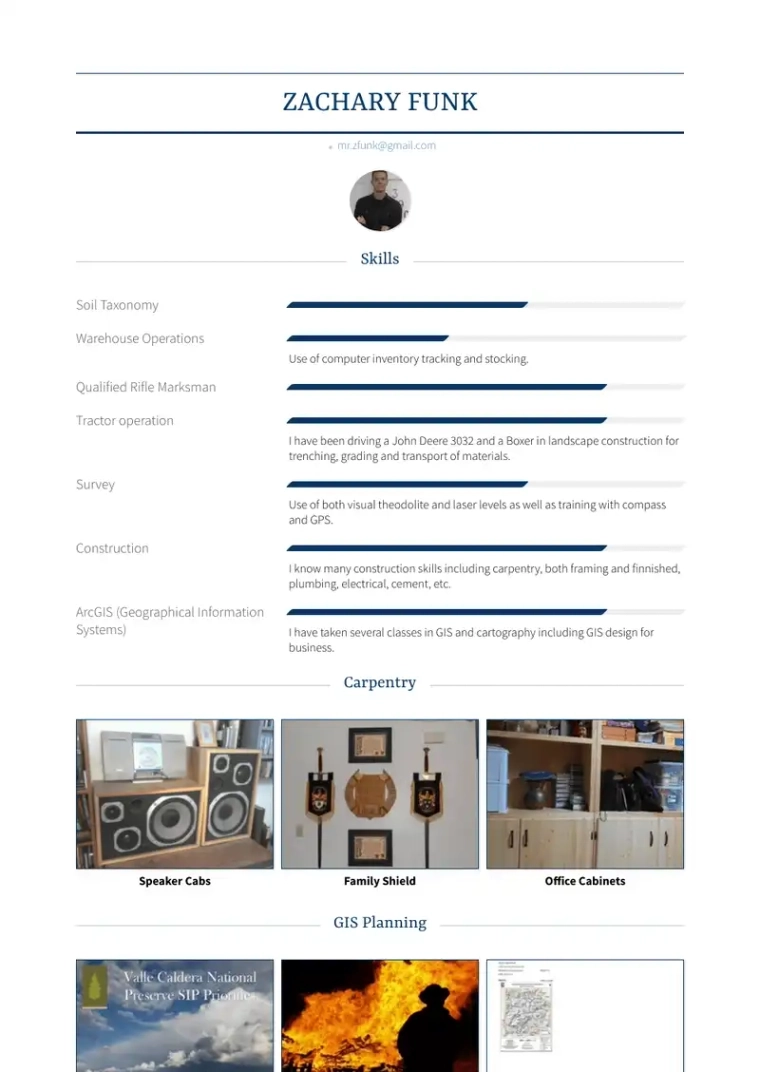
Combination Spanish Resume Example
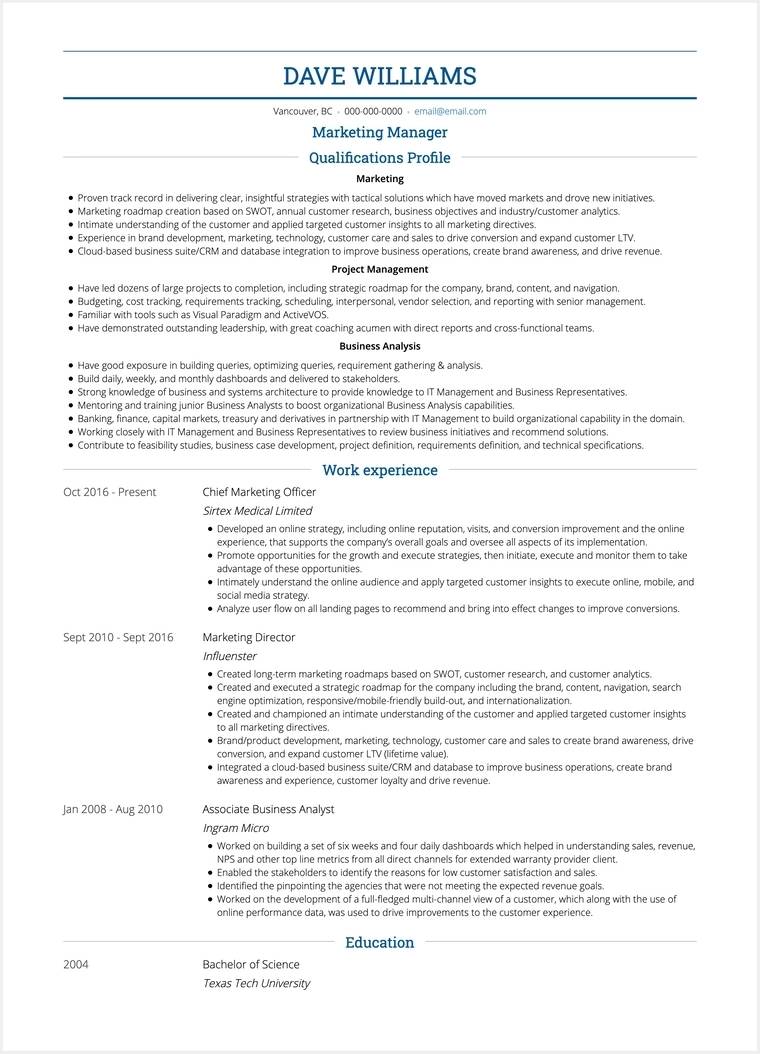
Administration Spanish Resume Example
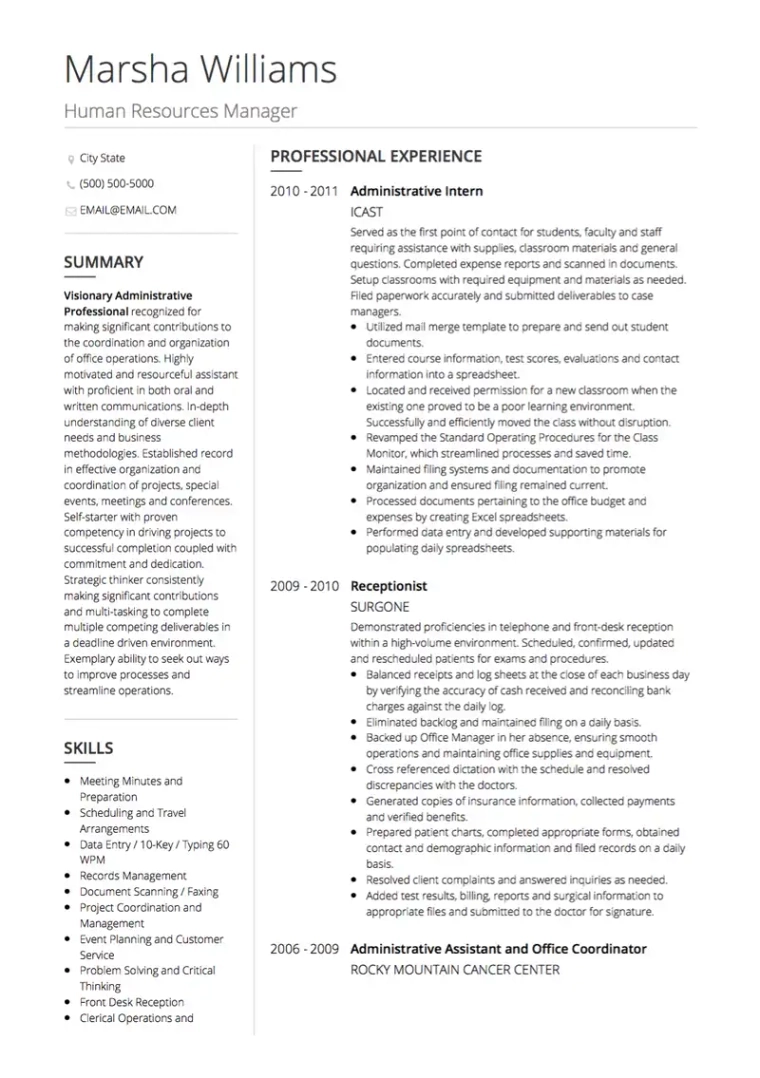
Retail and Customer Service Spanish Resume Example
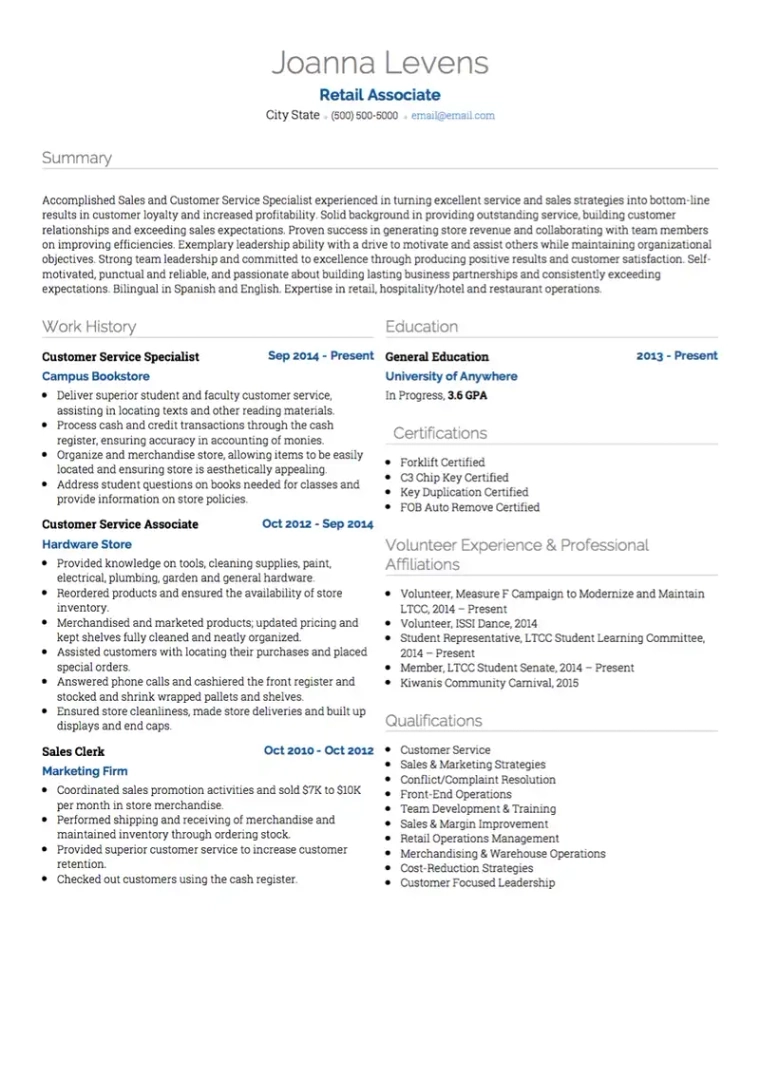
Professional Spanish Resume Example
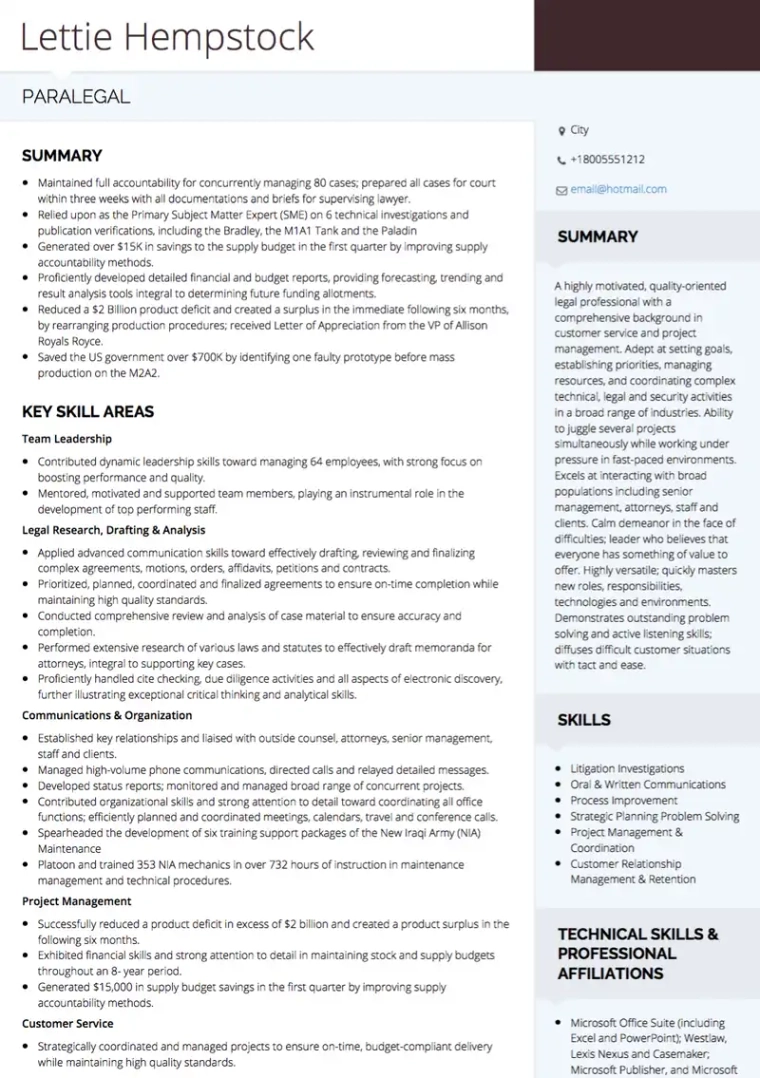
Engineering Spanish Resume Example
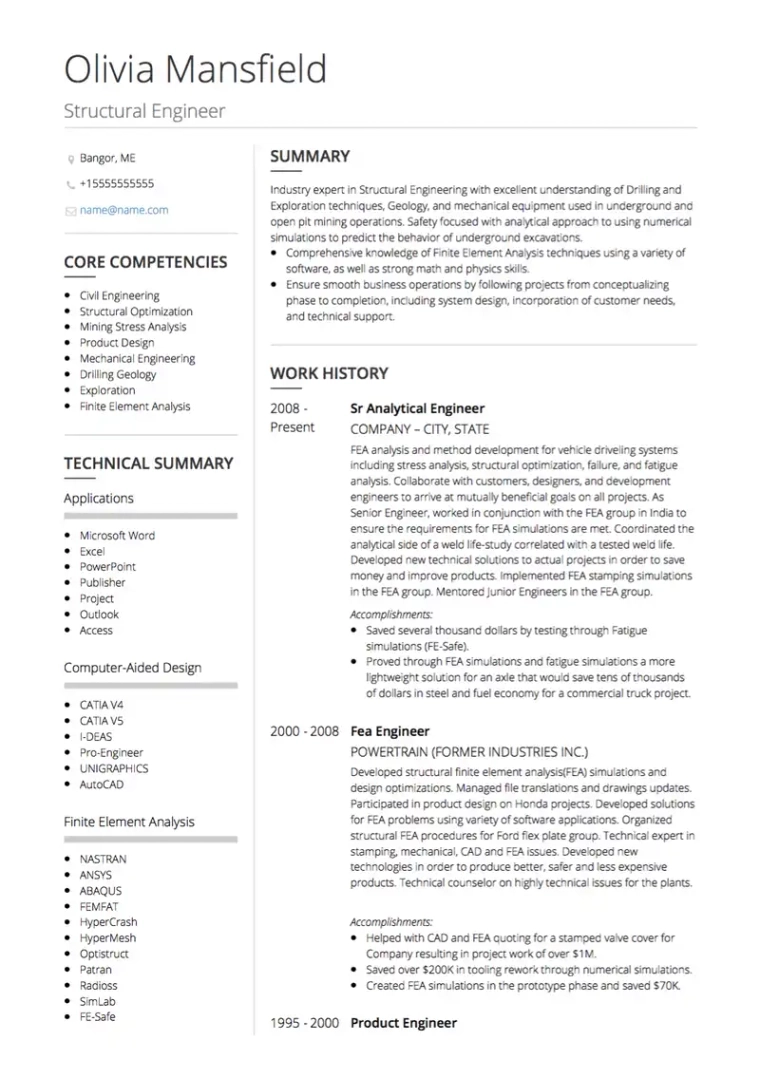
Marketing Spanish Resume Example
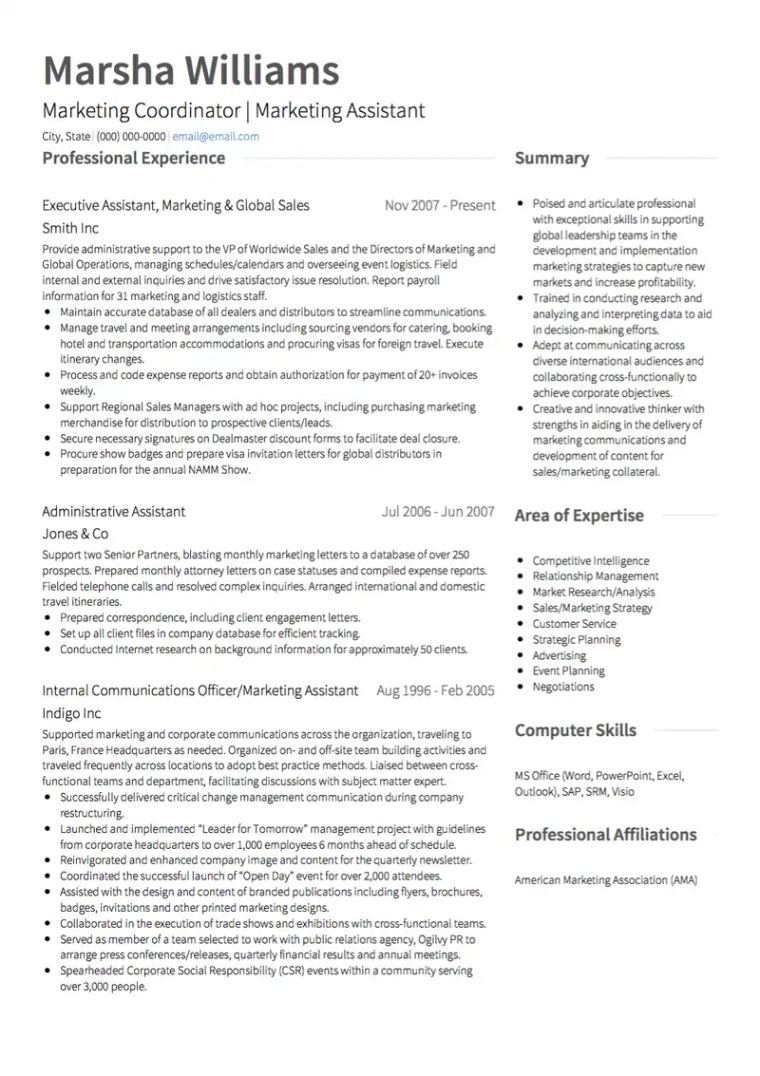
Management Spanish Resume Example
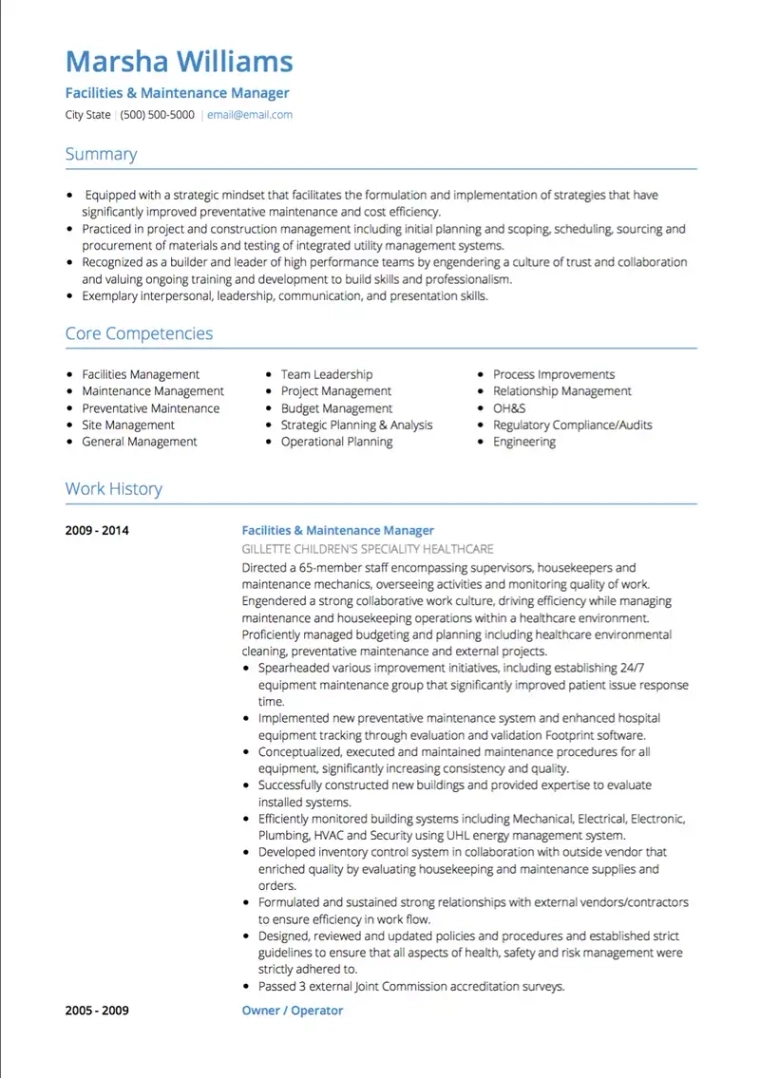
Finance and Accounting Spanish Resume Example
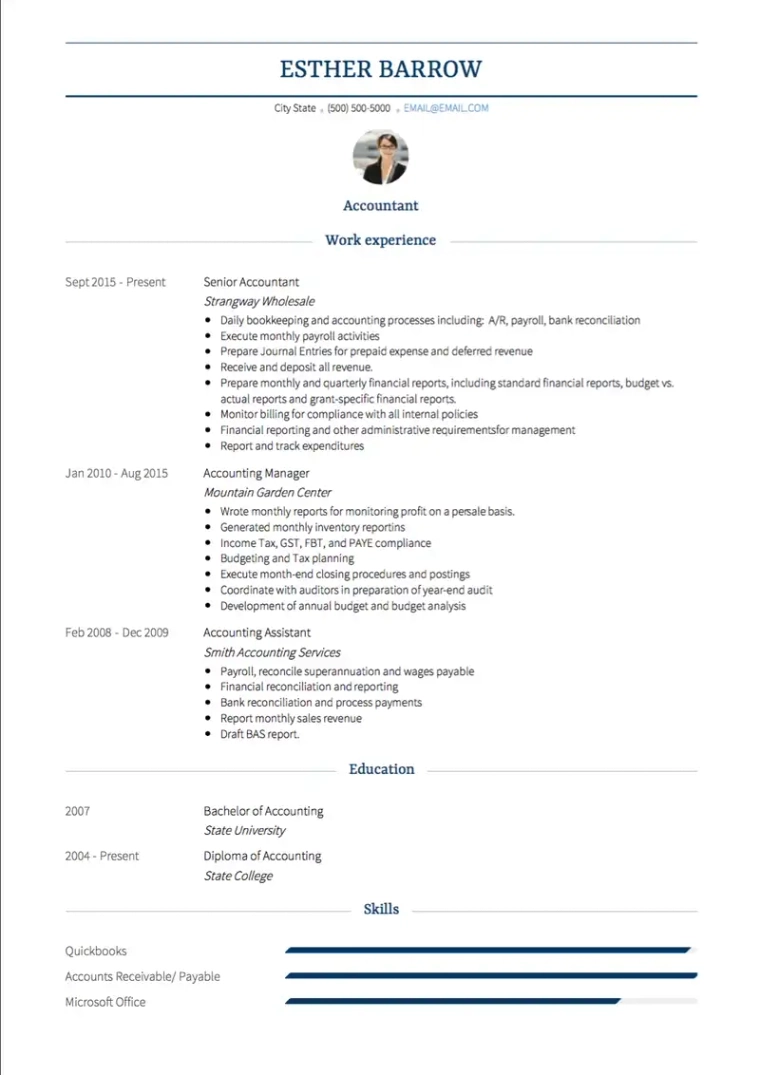
Spain CV Format, Order and Layout:
Photo: “In Spain it is very normal to include a photo on your CV”, according to Spanish Town Guides . An image directly on the CV is ideal, but you can include a picture separately if necessary.
Personal Information: Near the top of your CV, include your name, date of birth, nationality, full address, phone number, and email address.
Personal Summary: A personal summary is not required, but if you would like to include a few lines briefly describing your career history or career objective, that is acceptable.
Work experience: Write your Work Experience in reverse-chronological order. Use this section to sell yourself and your experience - focus on your achievements, but be sure to include your responsibilities as well. Use bullet points so that your work history is organized and easy to read.
Education: Showcase your education , including university name, area of study, and any certifications or degrees you earned. Unless you are a recent graduate, make sure this section does not overshadow your work history - according to cvrite , “If you have worked for more than three years it is usually better to include ‘Career History’ first, followed by ‘Education’.
Resume template: Browse through our gallery of Spanish resume templates .
Other Sections to Add in a Spain CV:
Skills: A Skills section where you provide a brief list of activities you are experienced with is a good addition to any CV. This section can efficiently show what your strengths are.
Volunteer experience: A volunteer section can be a great asset to your resume. It shows that you are well-rounded and have interest and experience in different areas.
Languages: As long as there is space on your resume, list all languages that you are fluent in.
References: It is acceptable to include a few references on your CV. The more impressive they are, the more impressive their inclusion will be. If you prefer, it is also acceptable to leave this out , providing references only when asked.
How do I write a CV for Spain?
To write a CV for Spain follow these steps:
- Select the right CV template for Spain. It should not be more than 2 pages in length.
- Add your name, email, Spanish phone number and link to portfolio in the header.
- Write a professional CV summary.
- Add your work history and try to show the impact you made at the current role and past roles.
- List your certifications in the certification section.
- Add all your skills in CV skills section.
- Finally, list your education.
How long is a CV in Spain?
A CV for Spain is usually no longer than 2 pages. Any CV more than two pages is considered too long in Spain.
Conclusion:
In Spain, as in many countries across Europe, a photo and date of birth are expected on your CV. The specific requirements of a CV varies from country to country - observing the rules and tips above is a great way to ensure that your CV suits the expectations of Spanish employers.
Copyright © 2024 Workstory Inc.
Select Your Language:
How To Write a Resume in Spanish
If you are applying for a job in a Spanish-speaking country, you will likely need to submit a resume in Spanish and follow the resume customs of that specific country. This article will cover when to use a Spanish resume, how it will differ from a North American English resume, and some useful terms and tips to help you get started.
When To Use a Spanish Resume
You will likely want to submit your resume in Spanish if you are applying to any position in a Spanish-speaking country or at a Spanish-speaking company anywhere in the world, unless speaking Spanish is not a requirement of the job. Consider which language the job posting is written in when deciding whether you should write in Spanish or English, as well as which language you would prefer to conduct a potential interview in. If you write your resume in Spanish, the employer will likely expect to interview you in Spanish as well, and vice versa.
In most Spanish-speaking countries, resumes are generally called CVs . In Spain, they may be referred to as ‘curriculums’ while in some parts of Latin America they may be called ‘hojas de vida.’
Differences From North American English Resumes
Obviously, there are many different Spanish-speaking countries around the world and each one has its own resume customs, so it’s important to research the specific country that you plan to work in. However, here are some general differences from North American English resumes that you will likely find:
Include a Photo
In most cases, it’s verboten to include a photo of yourself on a North American English resume due to concerns about discrimation. But, in many Spanish-speaking countries, it is normal and even expected to include a headshot on your resume. It generally isn’t mandatory unless the employer specifically mentions to include a photo with your resume, but many employers are accustomed to this practice.
If you decide to include a photo with your resume, avoid using a selfie or cropping an existing image. This should be a professional headshot (showing only your head and shoulders) in which you are dressed appropriately and smiling into the camera. When adding it to your resume, adjust the headshot to about the same size as your passport photo.
Include Your Personal Information
Again, personal information should generally be left off American, Canadian, or Australian English resumes , but it’s expected on most Spanish resumes. This information should include your full name, your age or date of birth, your address or the region you live in, your email address, your phone number (with a country code), your nationality, and your identification number that allows you to work in the country (if you have one).
In this section, you might also include information about your availability schedule, whether you have a driving license for the country, or any other certifications that are relevant to the job that you are applying for.
Place Education Details Before Work Experience
In some Spanish-speaking countries, more importance is placed on your educatio n than your work experience , so it’s often customary to place your education section immediately after your personal information.
In this section, include the name and location of the school or university, the dates that you attended, and the degree or certificate that you earned (including the Spanish equivalent if possible). You might also include the local equivalent of your GPA or other academic accomplishments to provide context for a potential employer.
Additionally, your education section can include professional courses or industry training programs - it’s not limited to academic degrees like English resumes.
Include Work Experience, Internships, and Volunteer Work in One Section
It’s common to list internships , volunteer work , and professional positions in your work experience section, whereas English resumes typically have separate sections for all three. For each entry, include your job title, the name of the company (including a brief description of the industry if it’s not apparent), the location, your dates of employment, and a description of your job responsibilities and duties. It is less common to include a bulleted list of achievements for each role on a Spanish resume, although it is becoming more popular.
Remember that Spain and Latin American countries use the date format DD/MM/YYYY. While you generally don’t need to include the day for your dates of employment, keep this in mind if you do write out any full dates on your Spanish resume or cover letter.
Adding a Skills Section Is Optional
A skills section isn’t compulsory on a Spanish resume, but it has become more common in recent years. So, you can add a skills section if you wish and if you feel it’s appropriate for the company and role that you are applying to.
Spanish Resumes Typically Include Less Detail
Since Spanish resumes historically don’t include skills sections or a bulleted list of accomplishments, it can be said that they are generally less detailed than North American English resumes. This may be more applicable to the older generations, as many younger Spanish-speaking workers are starting to include a higher level of detail.
However, it’s important to take into account local customs. An American-style resume that is simply translated into Spanish may come off boastful or aggressive in some Spanish-speaking areas.
Use Formal Language in Your Resume and Cover Letter
In English, of course there is only one word for ‘you,’ but remember that in Spanish ‘tu’ is used casually among friends and peers while ‘usted’ is used in formal situations or while talking to your superiors. Be sure to use the formal version in your resume, cover letter , and when otherwise interacting with your potential employer as a sign of respect.
Helpful Spanish Resume Terms
Here are a few Spanish terms that can come in handy while creating your Spanish resume:
- Nombre - Name
- Datos Personales - Personal Information
- Formación Académica - Education
- Experiencia Profesional - Work Experience
- Competencias - Skills
- Idiomas - Languages
- Aficiones - Hobbies /Interests
- Permiso de Conducir - Driving License
Tips For Writing a Spanish Resume
Finally, here are some tips to help you get started with your Spanish resume:
Include Language Abilities
Depending on the situation, you may want to include languages that you speak, including English and (hopefully) Spanish, as well as any other languages. Include your competency level using the scale that is most commonly used in the country where you are hoping to work. You might also include any formal language tests you’ve taken or certifications that you have earned in this section.
Don’t Exaggerate Your Spanish Language Abilities
Keep your resume language simple and don’t indicate that you are fluent in Spanish unless you truly are. If you are invited for an interview, the employer will be able to tell almost immediately whether you are truly fluent and comfortable with the language. It’s not worth exaggerating your skills to win an interview only to be immediately caught out, so be honest about your Spanish abilities.
Have a Fluent Spanish-Speaker Proofread Your Resume
However, even if your Spanish language skills are only conversational, that’s no excuse to submit your Spanish resume with errors on it. As such, you will likely want to ask or hire a fluent Spanish-speaker to read through your resume and help you correct any mistakes.
Use Reverse Chronological Order
Just like for English resumes, reverse chronological format is the most common. So, list your current or most recent details first and work back in time from there.
Account For Regional Differences
Finally, remember that there are many different Spanish-speaking countries, and, as mentioned earlier, each one will have its own customs and expectations when it comes to writing a resume. Research the specifics for the country that you intend to work in, and avoid simply translating your English resume into Spanish.
Key Takeaways
Writing a resume in Spanish may be necessary if you are applying to a position in a Spanish-speaking country or at a Spanish-speaking company, and the expectations will be different from a North American English resume. You will likely need to include a photo and personal details, but overall a Spanish resume will be less detailed when it comes to work history, skills, and so forth. Be sure to check the resume expectations for the exact country and region that you will be working in.
Need help creating your Spanish resume? Consider using Jobseeker ’s professional resume templates , which allows you to switch all of your resume section headings to Spanish with the click of a button. You can add a photo and a personal details section, and type in your information in Spanish. Then download your Spanish resume instantly and get started applying for jobs!
Get ahead of the competition
Make your job applications stand-out from other candidates.

Submitting a Resume: Is a Doc or PDF File Better?

How To Write a Targeted Resume: Tips and Examples

How to Include References on Your Resume
Step-by-Step Spanish Resume Writing Guide

Did you know that your perfectly crafted resume could seem poor-written abroad? Or even if you need a Spanish teacher resume, you need to keep some key points in mind.
Even if your resume could easily get you a job in your native country, it may lose its power in a foreign land. Thus, Spanish resume format has its peculiarities that should be taken into consideration.
Luckily, bilingual resume editors are ready to share a detailed guide that will help you to tailor your resume in accordance with Spanish cultural environment and business etiquette.

Choose the Language
If you look for a job in Spain, your resume should be written in the Spanish language, unless the job ad requires this document in English.
A resume written in Spanish could show the employer that you are qualified for the job in this country .
It is especially important if you write a high school Spanish teacher resume and deep knowledge of the language is necessary for the position.

Spanish Resume Format
A resume in Spain should have the following sections:
- Personal Details.
The Personal Details section should include the basic information about a candidate and his contacts. It is common to include your name, address, telephone, e-mail, date of birth, nationality, marital status, driving license type, and a photo .
If you already have NIE (tax identification number in Spain) you may add it to the list. Some of the rules applied to bilingual resume writing can also come in handy.
Keep in mind that the date in Spain indicates the day first, then the month, and the year. Do not forget to write the code of the country you live in. Asking about marital status and age is acceptable for the employer in Spain.
Including a photo in a resume is common but not obligatory. Remember these peculiarities while writing this section of your Spanish resume.
Personal Details section should also inform about your availability. You should mention if you look for a full-time or part-time job .
If you are available only during certain hours, do not forget to indicate it on your resume.
In this section, you write about your educational achievement and certifications. List your degree, the institution, the country and the city of the institution, the year you started and finished your studies.
In case you also took additional courses, workshops or took part in some programs, write about this under the heading Additional Education. This is especially important if you are writing a career change resume .
- Work History.
This paragraph should describe your professional experience. Start with the date, and then indicate the company you worked for, your position, the city, and the country.
Here you may also include your responsibilities and achievements you made while holding this position.
This section tells about your language skills. Start with your native language, and then list other languages you speak and the level of your knowledge.
Include the certifications that prove your language skills, if you have any.
- Computer Skills.
In this paragraph write about all the computer skills you have describing your knowledge of software.
List the programs and application you can work with such as Word, Excel, Adobe Photoshop, Dreamweaver , and others.
- Additional Information.
This section is optional and may contain the information about your hobbies, awards, prizes, or volunteer work .
The details in this paragraph should not be too personal. Make sure the information is related to the job and shows your qualification.
Also, pay attention to resume friendly name examples to make sure your application will get the attention it deserves!
Proofread Your Resume
Proofreading your resume is essential when you apply for a job in your country. When you look for a job abroad, double-checking the document becomes even more important.
Pay attention to the content, grammar, spelling, and readability. It would be great if a Spanish native speaker could check your resume. However, do not ignore applicant tracking system secrets too.
Ask your friend with a good knowledge of Spanish to have a look at it or use the help of a professional.


Top 5 Tips of Writing Spanish Resume
Learn spanish online.

Tip 1: Personal Information

Personal Information in Your Resume
Nombre y apellido: Jessica Smith = Name and surname: Jessica Smith

Fecha y lugar de nacimiento: New York, 26 de Febrero 1998 = Date and place of birth: New York, February 26th 1998

Lugar de residencia: Barcelona = Place of residence: Barcelona

Dirección: Calle Rosello 136, 08036 Barcelona = Address: 136 Rosello street, Barcelona 08036

Número de teléfono: 93 567 8901 = Phone number: 93 567 8901

Estado civil: Soltera, Casada = Marital status: Single, Married

Nacionalidad: Española = Nationality: Spanish

Correo electrónico: [email protected] = E-mail account: [email protected]

Tip 2: How to Mention your Work Experience on your resume
Puesto de trabajo: maestra de escuela primaria = job title: primary school teacher.

Nombre de la institución: Escuela Fort Pienc = Company name: School Fort Pienc

Fecha de inicio y finalización: 2011-2019 = Date: 2011-2019

Localidad:Barcelona = Location:Barcelona

Dirección: Carrer dÁlí Bei 75 = Address: Carrer dÁlí Bei 75

Tip 3: How to Highlight your Skill and Expertise on Spanish Resume
Idiomas: español (avanzado), alemán (básico) inglés (lengua materna) = languages:spanish (advanced), germán (basic), english (mother tongue).

Informática: Photoshop (Básico), Microsoft Office (Intermedio) = Computer skills:Photoshop (Basic), Microsoft Office (Intermediate)

Tip 4: How to Highlight your Education, Certifications while wirting resume in Spanish
2019- maestría de diseño de interiores ied- instituto europeo di design madrid madrid, españa = 2019- master of interior design ied- institute europeo di design madrid madrid, españa.

2016- Curso intensivo en Photoshop COCO- Escuela Europea para la Comunicación y Las Artes Visuales Alicante, España = 2016- Intensive Course in Photoshop COCO- European School for Communication and visual Arts Alicante, España

2016- Postgrado en Bienes Raíces- Administración en diseño y construcción ULC, Barcelona = 2016- Postgraduate degree in Real Estate- Construction & Design Management ULC, Barcelona

2012- Maestría en Diseño de Espacios Urbanos, Arquitectónicos y Movilidad. ESDESIGN- Escuela Superior de diseño de Barcelona = 2012- Master in design of urban, Architectural and Mobility Spaces ESDESIGN- School of Design of Barcelona

2010- Grado en Arquitectura Universidad Francisco de Vitoria, Madrid, España = 2010- Bachelor’s degree in Architecture University of Francisco de Vitoria, Madrid, España

Tip 5: Summary Note
Rule: Write down a Summary Note to go along with your CV giving very brief of your suitability. This is just 50 words describing your resume in nutshell.
Writing your curriculum in Spanish is not a matter of translation since there are some differences to take into considerations. Moreover, context and cultural differences must be considered when writing your resume in Spanish. Also, as a general rule, resumes written in Spanish tend to be shorter and less detailed than American ones.
Remember to use simple language, be concise, precise, professional and formal. You don’t need to be wordy to impress the recruiters. If you are not an advanced student of Spanish yet, keep your resume short and to the point. There’s no need to write elaborated paragraphs.
Resumen = Summary

Related Lessons in Intermediate Course, to further your understanding.

Which Syllable To Stress
Stress and related terms In Spanish
Cool Spanish Idioms
Learn Spanish Idioms
Explore a world of languages

- Skip to main content
- Skip to primary sidebar
- Skip to footer
SkillsetGroup

How to List a Second Language on Your Resume
July 26, 2022
In SkillsetGroup’s home territory, the U.S. Southwest, bilingual Spanish speakers are common. The greater LA area is also host to many who speak Vietnamese, Chinese and other Asian languages, as well as smaller neighborhoods with diverse languages from Hmong Daw to Palestinian Arabic. Even so, SkillsetGroup recruiters often work with candidates who don't know how to list a second language on their resume.
How Common Are Second Languages?
The following is from a report by the legal advocacy group Asian Americans Advancing Justice, Los Angeles:
- Nearly one in three LA residents (3.5 million), were born outside the United States
- 38% or 3.3 million speak Spanish
- 11% or 925,000 speak an Asian or Pacific Islander language.
Maybe it’s the routine exposure to multiple languages every day that makes some job candidates forget to list their second language skills from their resumes. Maybe using multiple languages is so common for them, they don’t even consider it a special skill employers might like in a candidate.
But, in case you haven’t figured it out from the title of this piece, you should always list your second language skills on your resume.
Even if a particular position you’re applying for doesn’t list a second language in its requirements, you’re leaving a potentially huge advantage out of your stated skillset. Especially in a geographic area that is home to a large multilingual population, your Farsi, Japanese or Hebrew skills might be the edge the hiring manager needs to hire you over another candidate.
“Virtually any professional in today's job market will benefit from having experience in multiple languages,” according to the National Career Development Association, a nonprofit resource for career counselors and job seekers. “Many positions now list ‘bilingual’ or ‘trilingual’ in the title, and others require a working knowledge of another language due to interaction with offices in other countries and business travel. Even when language skills are not required, with all other factors equal, having a foreign language on one's resume can provide an edge over candidates who are only proficient in English.”
How you present your skills will depend on the position you’re applying for – these tips below apply for resumes submitted for administrative, accounting or other jobs that are not primarily language focused.
(If you’re a translator or interpreter, presumably you already include your skills on your resume.)
List Your Language Skills Accurately
It may be tempting if you have just a bit of French or Spanish to slap it on your resume and hope no one at your employer questions you too hard. This is worse than not mentioning it at all if you must unexpectedly use the language on the job.
Even if you don’t mean to deceive, you may still have an inaccurate description of your skills on your resume. Don’t throw around terms like “fluent” or “conversational” without knowing exactly what they mean. One person’s “conversational” Spanish may be another’s “barely intelligible” Spanish.
How Do You Correctly Describe Your Language Skill Level?
When you list your second language on your resume accurately, it can give you a huge edge with hiring managers.
The following basic language skills designations are pulled from the University of North Carolina Wilmington’s business school:
- Basic Knowledge : This refers to an understanding of the language you might get from taking a 100-level college course. You know a few basic words and understand the construction. You can speak simple sentences and have some writing ability, but you still have trouble understanding native speakers.

- Conversant or conversational : This is an intermediate level. If you are conversant, you can have basic conversations in the language beyond “Where is the bathroom” to include simple info about family or personal interests.
- Proficient : This means you are an advanced speaker. You have all the basic language skills of someone who is fluent, but you might misunderstand fast speakers, and your vocabulary might not be as strong.
- Fluent : You are not a native speaker, but you can easily chat with native speakers with few grammatical errors. Reading and writing ability should be equally strong.
- Native speakers : As suggested by the name, native speakers grew up speaking the language and do it seamlessly without thought.
- Bilingual : You should only list this on a resume if you are truly bilingual, that is, speak both languages with equal proficiency and little accent in either.
Do an Administered or Self-Assessment of your Language Skills
Depending on your level of skill and the job requirements, you should have some objective gauge of your skill level.
The American Council on the Teaching for Foreign Languages offers proctored exams resulting in a recognized certification. Fortune 500 companies and government agencies use this test, so whatever certification you get will be widely recognized. It doesn’t come cheap, however.
If resources are an issue, do a self-assessment through the Interagency Language Roundtable (IRL). U.S. federal government agencies set up the service to “keep abreast of the progress and implementation of techniques and technology for language learning, language use, language testing and other language related activities.”
The site hosts three test forms, one for spoken proficiency, reading proficiency and listening/comprehension proficiency:
- ILR Language Speaking Proficiency Assessment
- ILR Language Listening Proficiency Assessment
- ILR Language Reading and Writing Assessment
This will let you list your language skill level with a precision many other candidates probably won’t bother to. The tests generate standardized designations 0-5 with a “+” added if you’re in between skill level tiers.
How to Format Your Language Skills on Your Resume
The level of your skills, the number of languages you speak and the particular job you want all factor in to how best to list your second language on your resume.
For example, if the job title is “bilingual customer service representative,” you’re going to want to present your second language skills prominently, perhaps in a dedicated resume section:

- Bilingual English-Spanish speaker
- 30 years using both Spanish and English personally and professionally
- Bilingual receptionist for 3 years
- Scored the highest designation (5) on ILR skill assessments in Spanish speaking, reading/writing and listening comprehension
- Comfortable with written translations and general written communications in English and Spanish…
If the job application mentions a second language as a “plus,” but not required, you likely want to list it slightly less prominently:
- Adobe Photoshop
- Conversational Spanish
- Advanced Excel Skills…
Make Sure Your Resume Follows Industry Standards
Of course, crafting your resume is an art, not a science. There are millions of how-to articles and Microsoft Word templates out there. For best results, read job descriptions carefully and research the resume conventions for your particular industry.
For example, in some sectors, resumes more than a page go directly in the trash. In others, a one-page resume is evidence of anemic professional experience.
For more information on how to craft your resume, GFCGlobal is a free educational resource with tutorials on this, business software programs and other career education resources.
Looking for a job? Search our hundreds of open positions!
“ LA Speaks: Language Diversity and English Proficiency by Los Angeles County Planning Area ”
Asian Americans Advancing Justice, Los Angeles
“ Resume Writing: Tutorial ”
GCFGlobal.org
The U.S. Interagency Language Round Table
“ Determining Language Proficiency ”
University of North Carolina Wilmington
Cameron School of Business
“ The Multilingual Advantage ”
Nataly Kelly
Career Convergence Web Magazine
The National Career Development Association
Language Testing International

About Steven Nuckles
Steven Nuckles is the Marketing Manager for SkillsetGroup
Enter your email to receive our monthly newsletter, full of labor market news, helpful tips, job openings, and in-depth knowledge from our internal experts.
Never spam, only valuable insights, we promise.
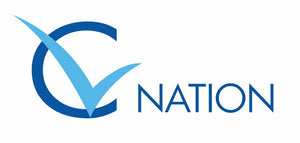
View Premium CV Package
How to Write a CV for Jobs in Spain (With Spanish CV Examples)
Posted by Phillip Jewell on Mar 02, 2020
A helpful, step-by-step guide to writing a job-winning Spanish CV or resume, including Spanish CV templates.
When pursuing jobs in Spain, your CV is one of your most important tools.
Whether you’re an English-speaking worker seeking jobs in Spain or you’re a Spanish resident, this guide will tell you exactly how to write a CV that impresses Spanish recruiters and hiring managers.
What's included in this guide?
- How to impress recruiters and hiring managers in Spain
- Everything English-speaking candidates need to know about writing a CV for jobs in Spain
- Which skills to include on your Spanish CV
- How to format your Spanish CV
- Two Spanish CV Examples
- How long your Spanish CV should be
- Whether to write your Spain CV in English or Spanish
The Importance of a Strong CV for Job Applications in Spain
Competition for jobs in Spain is high. At 13.7%, unemployment rates are significantly higher than the European average. Compared to other European countries – UK (3.8%), Germany (3.2%), Netherlands (3.2%), Portugal (6.9%) – Spain has a large number of unemployed residents. As of February 2020, unemployment is still on the rise in Spain.
Jobs at all ends of the spectrum in Spain are much higher valued than jobs in other European countries, such as the UK. With this in mind, it’s vital that you approach the Spanish job market with a strong CV that effectively articulates your competencies and is prepared in line with Spanish recruitment standards.
Use our advice and tips in this guide to make sure your CV does you justice and convinces recruiters that you’re the perfect person for the job.
*These unemployment figures were accurate as of December 2019, according to Google’s public data statistics.
*Sources for stats in this infographic: The stats in this infographic were taken from the following sources: Google Public Data (unemployment rate), Statista (percentage of service workers), Country Economy (minimum wage), Google Public Data (under 25 unemployment).
Spanish CV Example (English Version)
Spanish CV Example (Spanish Version)
How to Write a CV for Jobs in Spain
Photo and personal information.
Photos are commonly included on CVs in Spain. As photos are such a regular feature of Spanish CVs, it’s advisable to include one unless you have been instructed not to.
Photos can increase or reduce the effectiveness of CVs, depending on the type of photo included. Photos of candidates who smile confidently and wear appropriate attire indicate competence and professionalism.
With this in mind, it's important to take some time to prepare a photo that adds value to your CV. Ensure it is a professional headshot. Wear relevant attire and smile confidently at the camera. Photos in which candidates appears unhappy, aggressive or uninterested tend to generate negative results in the job market.
As with photos, Spanish recruiters and hiring managers tend to expect some personal information on CVs. This information should be included at the start of your CV. Ensure to include your date of birth, nationality and marital status.
If you operate in an industry where specific personal details are required, make sure they are included too. For example, if you work as a member of cabin crew, you may be required to add your height or arm length.
Professional Profile/Personal Statement
The professional profile/personal statement is arguably the most important part of your CV. A short introduction of around 100 words, strong professional profiles communicate your job skills and experiences and convince recruiters to spend time reading your CV. Professional profiles are often referred to as profiles, CV profiles and personal statements.
Points to consider when writing your professional profile
- Years of experience
- Areas of expertise
- Key skills and competencies
- Education and training
- Your passions and interests
Use powerful adjectives and avoid superfluous information. Identify your unique selling points and focus on what makes you a great employee. If possible, use numbers and statistics to enhance your profile and catch recruiters’ eyes.
Professional profiles can be written in sentence form, bullet points or a combination of both. Both have their own advantages. Bullet points enable the key information in your professional profile to stand out, while sentence form gives you the option of going into more detail.
In the professional profile example below, we’ve used the sentence format. Note how the candidate’s key skills and experiences are articulated in just a few sentences.
Spanish Professional Profile Example
Meticulous, customer-focused Waitress and Bartender, with over 4 years’ experience operating in four-star hotels across the UK. Recognised for optimising customer satisfaction by making guests feel welcome and maintaining a polite, hospitable demeanour during service.
Possesses a broad knowledge of standard operating procedures related to safety, hygiene and quality in the food and beverage industry. Utilises honed communication skills to engage with staff members from multiple departments and improve operational efficiency.
Applicant Tracking Systems (ATS) also come into play with professional profiles. ATS is a type of software used by recruiters and HR departments to filter and rank CVs based on specific keywords. As this software is widely used in modern-day recruitment, ensure to include the most relevant keywords for your profession.
For example, if you’re employed as a chef, important keywords would include kitchen management, menu design and people management. Take a look at the Spanish CV sample in this guide and notice how specific keywords have been peppered across the document.
Key Skills/Areas of Expertise
When you’ve included your personal details, photo and professional profile, it’s time to add a section dedicated to your skills.
When showcasing your skills, less is more. Don’t include your entire skill set. Not only would this make your CV too wordy, but it would also draw attention away from your most important skills.
Which skills should you include on Spanish CVs?
The most important skills to include on your CV will depend on your profession and industry. However, there are some skills that make strong impacts on all Spanish CVs. These include Spanish language skills and knowledge of Spanish regulations/legislation.
Of course, only include skills that you have mastered. It goes without saying that lying on your CV is never a good idea.
How to format your skills section
Use bullet points to make your skills stand out. Icons are another great way of drawing attention to your skills. We recommend focusing on no more than 10 skills. Any more than this will dilute your skills section.
In the CV example in this guide, notice how we’ve used five dots for each skill. These dots are used to measure the candidate’s proficiency with the skills, using a scale of one to five.
This approach enables you to communicate to hiring managers exactly how proficient you are with your skills. It's often important to state whether your skills are at an advanced level or not. For example, if you’re expert with Microsoft Excel, it’s important to convey this rather than leaving the reader pondering whether you’re a beginner.
Here is an example of a CV’s key skills section:
Work Experience/Career Summary
The next step is to articulate your work experience. This is arguably the most important aspect of your CV.
Use the reverse chronological format when detailing your career experiences (reverse chronological format starts with your most recent job and ends with your oldest job.)
What information should be included for each role?
Include your job title, the company name, location of employment and dates of employment. Always include both the month and year of employment.
As you will see in the CV example in this guide, we usually include one or two sentences below these details to provide some context. This may touch on the size of the company, your overall objectives and who you reported to.
Finally, include your responsibilities and achievements. Use bullet points and keep each point under two lines to ensure a simple reading experience.
Ensure to use powerful adjectives and verbs to bring your writing to life.
Examples of Powerful Adjectives
Examples of Powerful Verbs
- Effectuated
Here is an example of a Spanish CV’s career summary:
Education & Training
Include details of your relevant education and training. If you have completed training that is relevant to the Spanish job market, such as Spanish regulatory training or Spanish language training, ensure to showcase this in the education and training section.
Start by detailing your highest form of education. This might be a degree, A levels of GCSEs. Then move on to training programmes you have completed. Leave out any training that you feel is not relevant to the role you are pursuing.
Additional Information
Finally, add any further information that could support your applications. Additional information may include languages, IT proficiency, volunteering activities and licences.
If you don’t have any further information to add, skip this section.
When you’ve completed all six steps, proofread your CV and iron out any mistakes and typos. Polishing your CV is a great way of showing recruiters that you’re well organised and thorough.
Layout and Formatting for Spanish CVs
When preparing your CV or resume for applications in Spain, don’t exceed two pages in length. Those with less experience should opt for a one-page CV.
Ensure the margins of your document are not too wide or too narrow. Aim for between 1.5 cm and 2 cm on all sides of your CV. Using excessively narrow or wide margins will make your CV appear unprofessional.
Make sure you allow adequate spacing between text in your CV. This makes your document easier to read. To alter the spacing in Microsoft Word, highlight the text you would like to add spacing to, then click on the ‘Paragraph’ tab. Finally, alter the ‘Before’ or ‘After’ tab. We recommend selecting between 4 and 8 pt. of spacing between blocks of text.
Translate your CV
Even if you don’t speak Spanish, it’s extremely beneficial to translate your English CV into Spanish. While English is widely spoken in many areas of Spain, especially around the resort areas such as Benidorm and the Costa Del Sol, there is a very strong chance that the person reading your CV will be Spanish.
If you’re applying for business roles in Spain, it is vital that you translate your CV to Spanish as English is not widely spoken in this sphere.
Here at CV Nation, we offer CV translation from English to Spanish at reasonable prices. Click here to contact us to discuss our English to Spanish translation services.
Key Differences Between Spanish CVs and UK/US CVs
Personal details.
Many recruiters expect to see some personal information on CVs, unlike CVs for other European countries. While you don’t need to go into great details, you should include your basic personal details, including date of birth, marital status and nationality.
Unlike CVs for the UK and the United States, Spanish CVs should include a photo of the candidate. The photo should be a professional headshot.
Should CVs for Spain be written in English or Spanish?
We recommend preparing your CV in Spanish, whether you’re applying for an English-speaking job or a Spanish-speaking job. Even if you’re applying for English-speaking jobs that don’t require an understand of Spanish, it’s a good idea to get your CV translated into Spanish.
Submitting a CV in English may be considered unprofessional. Also, the recruiter reading your CV may not be fluent in English. If recruiters can’t understand some parts of your document, they might not be able to proceed with your application.
Which Jobs Are Most in Demand in Spain?
The most sought-after jobs in Spain depend on the region and city in question. However, the majority of jobs can be found in the services industry. This includes hospitality, IT and retail.
For expats and foreigners in Spain, some of the most popular jobs include:
- Tourism – Spain is a very popular destination for tourists. As such, there are always jobs to be found in the tourism industry. Popular jobs in this industry include bar work, catering and restaurant work.
- IT - With many tech companies in Spain, there are numerous IT opportunities, including programming and coding jobs.
- Customer Service – There are an abundance of international call centres in Spain, which are often on the lookout for people with great customer service skills. If you’ve mastered additional languages, such as German, then you may have a greater shot at securing roles in this area.
Hopefully this guide will help you to prepare a professional Spanish CV that impresses recruiters and hiring managers. If you would like to know more about CV writing, take a look at our complete CV writing guide .
Share this post
← Older Post Newer Post →
Explore Jobs
- Jobs Near Me
- Remote Jobs
- Full Time Jobs
- Part Time Jobs
- Entry Level Jobs
- Work From Home Jobs
Find Specific Jobs
- $15 Per Hour Jobs
- $20 Per Hour Jobs
- Hiring Immediately Jobs
- High School Jobs
- H1b Visa Jobs
Explore Careers
- Business And Financial
- Architecture And Engineering
- Computer And Mathematical
Explore Professions
- What They Do
- Certifications
- Demographics
Best Companies
- Health Care
- Fortune 500
Explore Companies
- CEO And Executies
- Resume Builder
- Career Advice
- Explore Majors
- Questions And Answers
- Interview Questions
How To Write A Resume In 7 Steps (With Examples)
- How To Write A Resume
- Resume Skills Section
- Resume Objective Section
- Career Objective Section
- Resume Reference Section
- Resume Summary Section
- Resume Summary Example
- Resume Interests Section
- Address On Resume
- Relevant Work Experience
- Anticipated Graduation Date On Resume
- Education Section On Resume
- Contact Information On Resume
- Statement Of Qualifications
- How To List Publications On Resume
- Accomplishments On Resumes
- Awards On Resume
- Dean's List On Resume
- Study Abroad On Resume
Resumes are still the most important document in your job search . Generating a professional and interesting resume isn’t easy, but there is a standard set of guidelines that you can follow. As hiring managers usually only spend a short time looking over each resume, you want to make sure that yours has a reason for them to keep reading.
If you’re looking to write a resume, rewrite a resume you already have, or are just curious about resume format, then you’ve come to the right place. This article will go through the steps to writing an excellent resume, as well as offering examples for what sections of the resume should look like.
Key Takeaways:
A resume is a short document that details your professional history in a way that tailors your experience and skill set for the particular job you’re applying for.
Resumes follow a few standard formatting practices, which hiring managers and recruiters expect to see.
Highlighting your work experience, skills, and educational background with relevant keywords can help you get past applicant tracking systems and into more interviews.

How to write a resume
Writing a resume involves using the proper formatting, writing an introduction, and adding your work experience and education. Stuffing your entire professional life into a single page resume can feel overwhelming, but remember that you’re distilling the relevant parts of your professional experience in order to catch the eye of the recruiter .
Formatting your resume. To start, use a word processor such as Microsoft Word or Google docs. Standard resume formatting calls for:
1 inch margins
10-12 point font
A professional, commonly-used font
Additionally, there are three resume formats that are commonly used. Most people should stick with a chronological resume format , but the combination resume format and functional resume format can be effective for more advanced workers or those who have significant gaps in their resume.
Write a resume header . It doesn’t matter if you have the best resume in the world if the hiring manager can’t contact you. Every single resume should include the following contact information:
Your full name. First and last.
Your phone number. Use a personal phone number, and make sure your voicemail is set up properly.
Your email address. Nothing inappropriate — [email protected] is a safe choice.
Location. City, State, Zip Code is fine, but you can include your full mailing address if you think it’s appropriate.
Your social media (optional). LinkedIn is the obvious one you’d want to include, but make sure your profile looks good. If you have an online portfolio , either on a personal blog/website or on a site like Journo Portfolio , feel free to include that here as well.
Your job title. Also optional, but can be useful for applicant tracking systems.
Resume introduction. You have four options for your resume introduction: a resume objective, summary statement, resume profile, or qualifications summary. For most job-seekers, a resume summary statement is the best choice. Regardless of which resume introduction you choose, avoid first-person pronouns (I/me/my).
Resume objective. A resume objective is the goal of your resume. Since the objective of every resume is to land a job, this is not the most original or impressive opener you can have.
On the other hand, it’s a good choice for an entry-level applicant or someone who is changing career paths . This should be a 1-3 sentence summary of why you’re motivated to get the position you’re applying for.
Who should use a resume objective: Entry-level applicants, career-changers, and recent college graduates.
Resume summary. This is the best opener for most job-seekers. As the name suggests, a resume summary highlights the most salient aspects of your resume.
It should include your current position, how many years of experience you have, some of your biggest achievements, and possibly your career goals. This should be a 1-3 sentence spiel and should include some quantifiable experiences.
Who should use a resume summary: Most job seekers; anyone with quantifiable accomplishments to emphasize and a broad range of skills.
Qualifications summary. A bullet point list (4-6 points is the sweet spot) of your qualifications for the position. It’s best used by applicants going for jobs that require a fixed skill set. It’s not a great choice for entry-level applicants who lack quantifiable achievements.
You’ll notice that a qualifications summary takes up more space than a resume objective or summary, but it can actually save the hiring manager time if you provide a bunch of valuable information right off the top.
Who should use a qualifications summary: Those applying to a job with requirements for certain skills and job-seekers who have a lot of experience in their industry and/or field.
Resume profile. A resume profile is similar to a resume summary, but goes into more detail about your accomplishments at your current or former job, while also telling the reader about your career goals. Think of a resume profile as a section that pulls all the best parts of your work experience section into one place.
Who should use a resume profile: Anyone with significant accomplishments under their belt, expertise in a niche field, or applying to a job in the same industry that they have lots of experience in.
Resume headline. Resume headlines aren’t necessary, but you can include one alongside any of the four types of resume introduction listed above. A resume headline comes between your contact information and the resume introduction of your choice.
Headlines can be used by entry-level applicants and experienced job-seekers alike. The important point is that your headline should be short and to the point. Additionally, you should use title case when writing your resume headline (capitalize words as you would for a book title).
Who should use a resume headline: Any job-seeker who wants to showcase their experience or unique value right off the bat.
Work experience. Your work experience section is the place to let hiring managers know that you have relevant experience that would allow you to handle the job you’re applying for.
If you’re using the chronological resume format, your work experience section would come after your resume summary/objective. In a funcitonal reumse, it would follow your skills section. Either way, work experience should be listed in reverse-chronological order (most recent experience at the top).
When listing your work experience, you should include all of the following information:
Job title. Start by stating the position you held at the company. These are easy cue for the hiring manager to look at and determine whether your past positions would help you succeed at their company.
Company Info. Include the name of the employer, the location where you worked, and perhaps a brief description of the company, if it isn’t a well-known name.
Dates Employed: Use the mm/yyyy format if you want to be sure that most applicant tracking systems (ATS) will pick it up. Whatever format you use for dates, be consistent, or your resume will look sloppy.
Job Description. Don’t just list your job’s responsibilities; hiring managers and recruiters already have an idea of your duties based on the job title. Instead, list your most important and impressive responsibilities/achievements at the job with bullet points. Determine which of these are most relevant for your new role based on the job description.
Ideally, each bullet should be no longer than a single line. However, two lines is acceptable, if used sparingly.
Always start with a strong action verb, followed by a quantifiable achievement and a specific duty. For example: “Developed ad campaigns for clients, increasing sales by an average of 27%.” Each job title should include 3-5 bullet points.
The order that you include this information can be changed around, as long as you are consistent throughout your resume. However, the bullet points detailing your job’s achievements should always be the last item for each entry.
It’s important that you tailor your resume’s work experience section to the job you’re applying for. We recommend reading the job description carefully and highlighting the action verbs in one color and the skills, adjectives, and job-specific nouns in a different color.
Educational background. In almost all cases, your education section should come after your professional history. If you’re a recent college graduate with limited work experience, you may choose to put your educational achievements first.
Like the section on your professional history, educational experiences should come in reverse-chronological order, with your highest level of education at the top. If you have a college degree, you don’t need to add any information about your high school experience. If you didn’t finish college, it’s okay to give a list of what credits you did complete.
Each educational experience can be listed in the following format:
Degree/Program Name College/University Name Dates attended
You don’t need to add anything else, especially if your resume is already impressive enough. But if you’re struggling to fill up the page, or you feel that aspects of your educational experience will help make you a standout, you may consider also including:
Minor. If you think it rounds out your not-exactly-relevant-to-the-job major nicely.
GPA. Only if it was 3.5 or higher. Otherwise, it’s not going to do you any favors to include this.
Honors. Dean’s List, Cum Laude, etc.
Achievements. If you wrote a killer thesis/dissertation that showcases intimate knowledge relevant to the job to which you’re applying, you can include its title and a very brief description.
Extracurricular activities. Only include if they’re relevant. For example, if you’re applying for a management position and you were president of your student government.
Certifications/Licenses. If the job you’re applying for requires/likes to see certain certifications or licenses that you have, you may include them in this section as well.
Skills section. Your impressive skills should be scattered logistically throughout your professional history section, but you should also include a section solely dedicated to highlighting your skill set . Skills can be broken down into two categories:
Hard skills are skills you learn through training and indicate expertise with a technical ability or job-specific responsibility.
Soft skills are your personality traits, interpersonal abilities, and intangible qualities that make you more effective at your job.
Your resume should have a healthy mix of hard and soft skills, as both are essential to job performance. However, since soft skills are harder to prove in the context of a resume, we recommend leaning more toward hard skills. Additionally, whenever you list a soft skill, make sure that it has a correlating item in your work experience section.
For example, if you say you are skilled in collaboration, you should mention a time when a team project was a major success somewhere in your work experience section.
Optional sections. If you still have space left or there’s more you want to show off that doesn’t quite fit in any of the above sections, you may consider adding an additional section covering one or more of the below categories:
Language . Being bilingual is always impressive, and can be included on a resume for any company. Highlight this more if your position involves liaising with international distributors and/or clients. Don’t lie about your proficiency level.
It may be best to not mention it if you’re not particularly proficient speaker . Such as if you took courses in school, or haven’t really managed to gain fluency. It can end up looking like an attempt to inflate your credentials, which you want to avoid.
Volunteer experience . Always a good thing to include. It shows you’re a team player who behaves in a way that promotes the greater good, without thought of personal gain. Especially good for entry-level candidates and those applying for jobs at a non-profit. If you have gaps in your work history, you can also consider including volunteer experiences in your work history section instead.
Personal projects. A personal blog, published works, or a portfolio of your past projects are all good things to include. They show you take initiative, enjoy and take pride in your work, and that you can handle the responsibilities of the job, if relevant.
Certifications/licenses. If you didn’t include these in your education section, this is another good place to list relevant certifications or licenses that you have.
Interests . This is largely just a space filler if your resume is light in other areas. However, if your hobbies are directly related to the job that you’re applying for, it’s not a bad idea to include them. And it might draw a recruiter’s attention if you end up sharing some of the same interests as they do.
If you have several seemingly random items that are valuable, but don’t warrant creating a whole separate section for, you can also make a section called “Additional Experience.” Here you can include all of the above categories in one place. Just make sure that each item is clear and easy for readers to understand.
Resume samples
Now that we have a good idea of how to write a resume, let’s take a look at some example resumes:

Jack Pilgrim Washington , DC 14015 – (555) 444-3333 – [email protected] – www.linkedin.com/jpilgrim Resume Summary Graphic designer with 3+ years of experience creating and implementing promotional materials and social media graphics. Worked with sales and marketing teams to increase inbound calls by 23% YoY through compelling digital media. Adept at planning, managing, and prioritizing multiple deadlines at once, and thrives in fast-paced work environment. Work Experience Creative Designs | Washington, DC Lead Graphic Designer | June 2018-Present Worked with sales and marketing teams to create landing pages, sales proposals, and supporting media elements to drive sales by over $250,000 per quarter Trained, managed, and mentored team of 4 junior designers to fulfill 40+ project orders on a weekly basis Conducted UX research through surveys, usability testing, and data analysis to plan content marketing strategy, driving organic search traffic by 12% Presented proposals, results, and status updates to set of 4-7 clients, ensuring customer satisfaction at or above 95% for 3 years straight Happy Place | Alexandria, VA Junior Graphic Designer | July 2016-May 2018 Translated client needs and branding strategies into design and content strategy, increasing client retention by 22% Reduced project turnaround time by 8% by Utilizing web-based ticket system for completing and archiving finalized pieces Posted digital artwork to network IPTV using web interface to produce high-end info-graphics and other materials Happy Place | Alexandria, VA Marketing Intern | September 2015-July 2016 Assisted marketing team with data collection, analysis, and presentation using Google Analytics Drew up storyboards for new marketing campaigns alongside sales team, increasing brand awareness through social media Wrote 500-1000 word articles to pair with graphical elements on page, leading to a 40% boost in engagement on company website Education Savannah College of Art and Design | Savannah, Georgia May 2016 Bachelor of Fine Arts in Graphic Design Skills Adobe Creative Suite Typography HTML/CSS WordPress Collaboration Organization
Allison Neederly Chicago, Illinois , 60007 | (333) 222-1111 | [email protected] | www.linkedin.com/allison.neederly Resume Summary Dedicated customer service representative with 4+ years experience resolving customers’ needs in-person, online, and over the phone. Top achiever at XYZ Inc. with a 100% customer satisfaction rate for Q1 of 2020. Friendly personable, and knowledgable about company’s products and services. Relevant Skills Customer Service Responded to upwards of 200 customer queries daily with XYZ Inc., reducing the average wait time by 56% and increasing customer satisfaction rates by 13% Ability to resolve conflict and create a positive atmosphere for shopping for both new and existing customers through technical proficiency Expert product knowledge and communication skills, and experience training and mentoring new customer service staff Web Chat and Phone Skilled in 3 web chat platforms for helping online customers resolve their queries quickly and accurately Achieved fastest call resolution rate at XYZ Inc., with an average resolution time of under 5 minutes per customer Performed outbound calls for customer satisfaction surveys, as well as writing web-based surveys for 10,000+ customers Troubleshooting Detailed product knowledge allowed for customer technical issues to be resolved at rate within top 5% of all customer service associates at XYZ Inc. Created manual for step-by-step directions for troubleshooting that was implemented for team of 100+ customer service reps Positive attitude took average tech-related negative response from 1/5 stars to 4/5 stars, increasing trust in brands and services Work Experience XYZ Inc. | Philadelphia, PA Customer Service Associate New Look Global | Burlington, VT Junior Customer Service Representative L.L. Bean | Burlington, VT Sales Associate Education University of Vermont | Burlington, VT May 2012 Bachelor of Arts in Humanities
Priya Laghari New York, NY | (222) 111-0000 | [email protected] | www.priyabizdev.com Resume Profile Strategy Development: Grew John Deere’s international sales by 13% by tapping into undeserved countries in Southeast Asia Management: Oversaw a team of managers representing marketing, sales, and product teams. Streamlined collaborative, cross-functional communications through agile and scrum management system CRM: Developed, customized, and implemented new customer relationship management database for accounts totaling over $10M in value Work Experience Business Development Manager 01/2015-Present Microsoft | Redmond, WA Developed product strategies and roadmap for Google AdWords, increasing inbound traffic by 26% YoY Reduced time training on new software by 50% for new and existing employees by implement e-learning programs Spearheaded digital marketing campaign worth $1M that saw a return of 200% in first year by qualifying leads earlier in the sales funnel Regional Sales Manager 11/2012-01/2015 Big Things Inc. | St. Louis, MO Managed territory encompassing 29 regional locations with an annual revenue of approx. $55M Worked with C-level executives to plan business strategies, resulting in 20% reduction in overhead costs Increased client retention by 12% in first year by implementing a CRM approach based on account profiling and elevating levels of relationship selling Account Manager 02/2009-11/2012 Solutions Corp. | Chicago, IL Implemented and developed CRM strategic plans, increasing retention of long-term clients by 22% Maintained 50+ accounts totaling over $35M in value Generated leads through one-on-one consultation via phone inquiries, online check-ins, and meeting office walk-ins Relevant Skills CRM: Proficient with Salesforce, Zoho, and HubSpot; some experience with Keap. Used various CRM software over a decade to successfully manage customer relations and quick to adapt to new software and tools that aid in quality of customer experience. Salesmanship: Negotiated and closed over several deals worth $1M+ and skilled in upselling and cross-selling. Adept at working closely with marketing and product teams to maximize the efficiency of the sales funnel for both inbound and outbound traffic. Presentation: Represented Microsoft Northwest Region at quarterly board meetings, ensuring all stakeholders were kept abreast of new developments and opportunities. Also deliver monthly presentations to big clients and vendors to maintain positive relationship. Data analytics. Expert at integrating data from various analytics platforms, including Google, Microsoft Power BI, and SAP BusinessObjects Education Colgate University | May 2008 MBA Fordham University | May 2006 Bachelor’s Degree in Business
For more resume examples and templates:
Resume examples by job
Google docs resume template
Resume templates
Resume builder
Resume Headers Samples:

Tip : Never put your contact info in the header of your document; some applicant tracking systems might miss it.
For more on how to write a resume header:
Resume Header
Resume Titles
Resume introduction examples
Entry-Level Resume Objective.
Recent graduate with a bachelor’s in Marketing from the University of Virginia seeking an entry-level role in content marketing. Excellent copywriter with 2+ years experience editing content as a member of the UVa Writing Center.
Career Change Resume Objective.
Eager to apply 7+ years of experience with customer success management to make successful outbound B2B calls, deliver customized business solutions to new and existing customers, and provide expert product knowledge in the role of Account Manager for XYZ Inc.
Example Resume Summary Statement.
Accountant with over 8 years of experience in the medical industry. Adept at advising on management of cash deficits, reconciling departmental accounts, and creating new accounts and codes. Coordinated invoice preparation system for ABC that reduced contractor overhead by 19% YoY.
English teacher with a love of language and 6 years of experience teaching high school students. Developed new curriculum that boosted freshman reading comprehension scores by 12% and created after school book club for AP Lit class, resulting in 100% of participating students achieving a 5 on the AP Lit test.
Example Qualifications Summary.
Executive assistant with 5+ years experience helping maintain efficiency in an office of 25 employees Communicated directly with internal and external stakeholders, helping Senior Vice President manage projects worth $5M+ Proactively managed office schedules, identifying and prioritizing changes to ensure client satisfaction Recognized in a company of 500 for “Outstanding Achiever” in May 2019
Example Resume Profile.
Detail-oriented IT Specialist with 4 years of experience overseeing and improving the infrastructure of IT systems. Adept at building and running troubleshooting systems and testing services. Decreased security risk by 47% through continual optimization, while also improving the speed of client portal by 22%. Excellent communicator both internally and for client-facing discussions. Achieved 98%+ customer satisfaction ratings through weekly and monthly check-ins with accounts valued cumulatively at $500,000.
Entry-Level Resume Headline.
Bilingual College Graduate with 80 WPM Typing Speed and Tutoring Experience
Experienced Resume Headline.
Business Development Specialist with 6+ Years Experience Scaling Start-Up Tech Teams
For more on resume introductions:
Resume objective statement
Resume summary statement
Resume summary statement examples
Qualifications summary
Sample resume work experience sections

Work Experience XYZ Industries | Seattle, WA Marketing Associate | May 2019-Present Delivered weekly presentations to client-base to communicate brand messaging, increasing client retention by 11% Served as liaison between marketing and product teams, resulting in projects finishing 2 weeks early, on average Leveraged Excel skills to create and maintain spreadsheet to track consumer insights, emergent trends, and inform decisions of marketing team through competitive analysis Managed team of 5 contractors to juggle multiple priority projects simultaneously, never missing a deadline Initiated an affiliate referral program that PR team went on to turn into a revenue-generating stream valued at $30,000 annually ABC Corp | Seattle, WA Marketing Intern | September 2018-May 2019 Developed, maintained, and processed 20+ digital consent forms and distributor forms Worked collaboratively with a team of 10 marketing professionals, closely aligning our goals with the PR team Provided data analysis using Google Analytics and performed keyword research to increase blog traffic by 56% over six months Answered up to 50 customer queries by phone and email each week
For more on building the perfect resume work experience section:
Resume work experience section
First resume (no experience)
Examples Of Education Resume Sections
Graduated recently from a 4-year program.
Western Illinois University | Macomb, Illinois May 2020 Bachelor of Arts in Sociology | Minor in Psychology 3.95 GPA magna cum laude Dean’s List all semesters
Two degrees.
Fordham University | Bronx, New York April 2016 Master of Chemical Engineering Stony Brook University | Stony Brook, New York April 2014 Bachelor of Science in Chemistry
Anticipated graduation date (not yet graduated).
DePaul Univeristy | Chicago, Illinois Bachelor of Arts in History – Degree anticipated May 2021 Current GPA: 3.8
Older job seeker (graduated 10+ years ago).
University of Chicago | Chicago, Illinois Bachelor of Business Administration
High school graduate (no college degree).
Johnston High School 2016-2020 Head of Computer Club
More on crafting the perfect resume education section:
Education resume section
GPA on resume
Dean’s list
Magna cum laude
Examples Of Skills For Resume
Examples of hard skills include:
Examples of soft skills include:
Here’s more information on how to incorporate skills into your resume:
Resume skills section
Hard skills
Soft skills
Top skills for professionals
Skills-based resume
Resume writing FAQ
What is a resume?
A resume is a one to two-page document that focuses on professional experience, past achievements, education and certifications, and specific skills tailored to the job you’re applying for.
Almost every job application requires a resume, and hiring managers use them as a first impression in determining which applicants get a shot at an interview.
Whether you’re fresh out of college or have 30 years of professional experience, this guide should help craft a resume that stands out from the crowd and get you one step closer to landing your dream job.
What is the format for writing a good resume?
Most people will want to use a chronological or reverse-chronological resume format. This format is compatible with most applicant tracking systems (ATS) and is easy for employers to read. Additionally it helps highlight your experience, which helps prove your qualifications.
How far back should a resume go?
A resume should go back no further than 10 to 15 years. However, it is important that all your information is relevant. Therefore, do not include job experience that is irrelevant to your application, even if it’s fewer than 10 years old. Save that information for later discussions.
Should you personalize your resume for each job?
Yes, you should personalize your resume for each job you apply to. Many recruiters use ATS now, which will search for keywords in a resume and reject those that don’t have them. That means that the skills you choose to highlight as well as your opening, such as your resume summary, should be altered to suit each job you apply to.
You don’t need to rewrite the entire resume for each job, but it does show attention to detail and initiative to make sure that your resume is customized. It also makes it more likely that you’ll get past the first step of the process.
State of New York Department of Labor – Resumes, Cover Letters and Job Applications
Harvard University – Create a Resume/CV or Cover Letter
How useful was this post?
Click on a star to rate it!
Average rating / 5. Vote count:
No votes so far! Be the first to rate this post.

Matthew Zane is the lead editor of Zippia's How To Get A Job Guides. He is a teacher, writer, and world-traveler that wants to help people at every stage of the career life cycle. He completed his masters in American Literature from Trinity College Dublin and BA in English from the University of Connecticut.
Recent Job Searches
- Registered Nurse Jobs Resume Location
- Truck Driver Jobs Resume Location
- Call Center Representative Jobs Resume Location
- Customer Service Representative Jobs Resume
- Delivery Driver Jobs Resume Location
- Warehouse Worker Jobs Resume Location
- Account Executive Jobs Resume Location
- Sales Associate Jobs Resume Location
- Licensed Practical Nurse Jobs Resume Location
- Company Driver Jobs Resume
Related posts

Resume For A Part-Time Job (With Examples)

Standard Resume Margins (Size + Formatting)
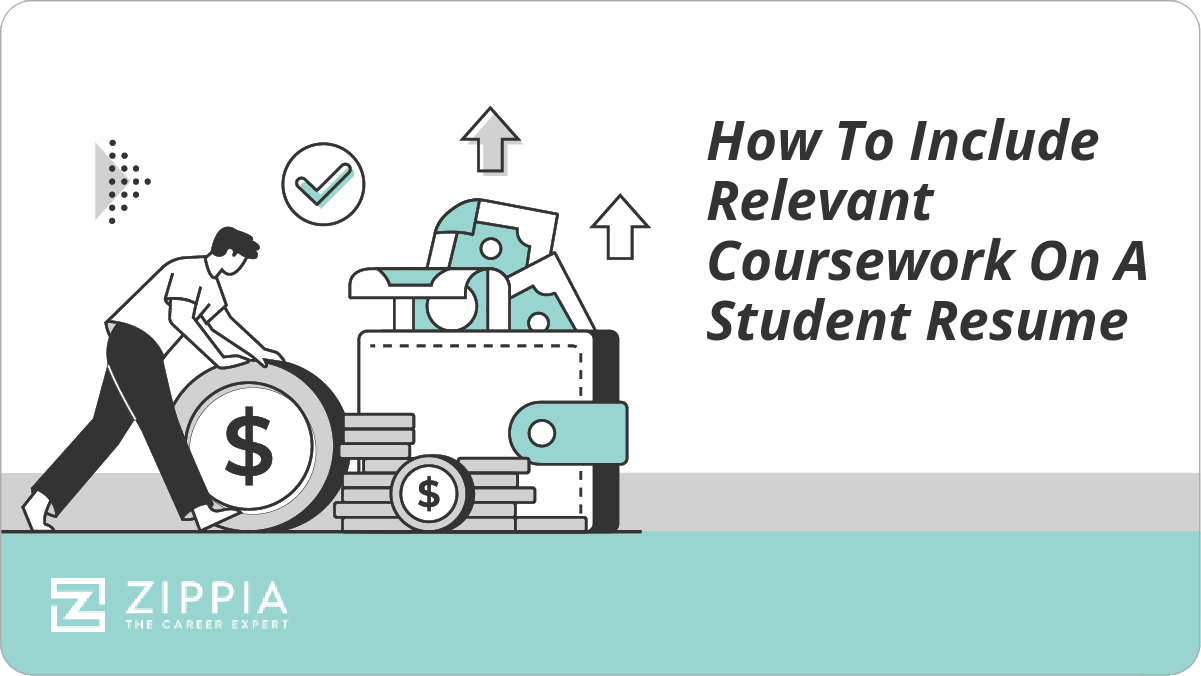
How To Include Relevant Coursework On A Student Resume

Show Multiple Positions At The Same Company On A Resume
- Career Advice >
- Resume Structure >
- Parts Of A Resume >

IMAGES
VIDEO
COMMENTS
In standard Spanish CVs, margins should measure 3 cm (just over 1 inch) from the top of the page and 2.5cm (1 inch) from each side. Another rule to take into account to create a correct Spanish resume format is the heading or title you put at the beginning of the page.
Objetivo, resumen o perfil (Objective/Summary) ️ one or two sentences about your application. Experiencia laboral (Work experience) ️ your past work experience, including dates of employment, company name, and job title. You can also briefly outline your responsibilities.
Select the right verb. In most Spanish-speaking cultures, your resume must be written in the first person (without the pronoun "yo"), in the past tense for previous experience, and the present tense for current roles. However, in some Latin American countries, the third person is used for specific occupations.
Tips to Write Your Resume in Spanish. Use Bullet Points. Keep Your Grammar Simple. Learn the Appropriate Vocabulary. Ask a Native Spanish Speaker to Proofread Your Resume. Example of a Resume in Spanish: The Ideal Template. →Sign Up Now: Free Trial Spanish Lesson With a Native Speaker Teacher!←.
Choose the Right Verbs. In most Spanish-speaking cultures you must write your resume in the first person (skip the pronoun "yo" though), in the past tense for previous experience, and present for current roles. However, in certain Latin American countries it is customary to use the third person for specific careers.
Here are three steps to follow to add language skills to your resume: 1. Determine the language rating system you will use. Depending on the job requirements, a basic note after each language using the beginner to native scale listed above can be sufficient. If you have taken the ILR assessment, you may include the ILR rating after the language ...
Here are the key sections to include in a Spanish resume: Header: "Datos personales": This section should include your full name, phone number, email address, and location. Resume summary: "Perfil": Two to three sentences about your experience and career goals.
Select the right CV template for Spain. It should not be more than 2 pages in length. Add your name, email, Spanish phone number and link to portfolio in the header. Write a professional CV summary. Add your work history and try to show the impact you made at the current role and past roles. List your certifications in the certification section ...
Writing a resume in Spanish may be necessary if you are applying to a position in a Spanish-speaking country or at a Spanish-speaking company, and the expectations will be different from a North American English resume. You will likely need to include a photo and personal details, but overall a Spanish resume will be less detailed when it comes ...
Spanish Resume Format. A resume in Spain should have the following sections: Personal Details. The Personal Details section should include the basic information about a candidate and his contacts. It is common to include your name, address, telephone, e-mail, date of birth, nationality, marital status, driving license type, and a photo.
Template for career summary or objective. Here's a template of how to include your ability to speak, read, and write Spanish in your career summary: A [job title] with a [educational qualification] from [school]. My passion is [list your passions]. I'm fluent in [language 1, language 2] and proficient in [language 3].
Describe your fluency level. 1. Determine the relevance of your bilingual skills to the position. Review the job posting to learn if the position requires bilingual skills. If it mentions that the company prefers candidates proficient in a language you speak, you can list this skill near the top of your resume.
Tips on writing a Spanish CV. Here are some simple tips to help you write your Spanish resume: Always proofread your resume for spelling or grammatical errors. Remember, it is the recruiter's first impression of you. You might also want to ask someone else to look over it before you send it out. Avoid personal pronouns such as "I" or "me"
1: Your CV or La hoja de vida in Spanish La hoja de vida or CV-as Spanish speakers refer to the resume- is a summary of our education and work experience, skills and accomplishments.If you are interested in applying to a job in a Spanish speaking country, you definitely need to know how to write a resume since there are slight differences with a resume written in English.
Writing Resumes, CVs & Cover Letters in Spanish. Lesson Transcript. Instructor Yolanda Reinoso Barzallo. Yolanda holds a CELTA Cambridge, a Juris Doctorate, and a Master of Public Administration ...
Determine your strengths and weaknesses so you can accurately define your levels of proficiency on your resume for a potential employer. Reading: This describes your ability to understand written language. Writing: Writing proficiency evaluates your ability to write comfortably using a second language. Speaking: Speaking proficiency evaluates ...
Download our free resume in Spanish and get the job of your dreams in Spanish-speaking territories. Get hired faster by using this template, which you can edit and customize according to your style preferences. Download this example resume in Spanish now! File format: Word (Microsoft) File size: 173 KB. Ready-to-use: fast, easy, and free.
Scale for resume language skills. Basic: suggests that you understand basic words and phrases, but are unable to hold a conversation. Intermediate: suggests you can hold a basic conversation in the language, but have limited vocabulary, a low understanding of grammar rules, and may not be able to read.
For example, if the job title is "bilingual customer service representative," you're going to want to present your second language skills prominently, perhaps in a dedicated resume section: Languages. Bilingual English-Spanish speaker. 30 years using both Spanish and English personally and professionally.
During this workshop, you will learn different résumé styles, as well as the importance of using keywords in your résumé and what hiring managers respond to ...
A helpful, step-by-step guide to writing a job-winning Spanish CV or resume, including Spanish CV templates. When pursuing jobs in Spain, your CV is one of your most important tools. Whether you're an English-speaking worker seeking jobs in Spain or you're a Spanish resident, this guide will tell you exactly how to write a CV that impresses Spanish recruiters and hiring managers. What's ...
Spanish to English. Possible Results: résumé - el currículum. See the entry for résumé. resume - reanudar. See the entry for resume. resume - reanuda. Affirmative imperative conjugation of resume. There are other translations for this conjugation.
https://bit.ly/3FHkZRG ← if you want to learn more vocabulary, phrases, and example sentences you can use in real-life situations, click here to download you...
Writing a resume involves using the proper formatting, writing an introduction, and adding your work experience and education. Stuffing your entire professional life into a single page resume can feel overwhelming, but remember that you're distilling the relevant parts of your professional experience in order to catch the eye of the recruiter .